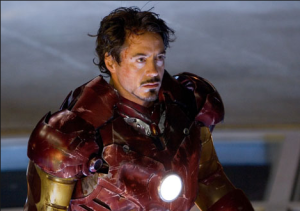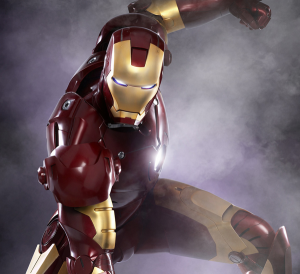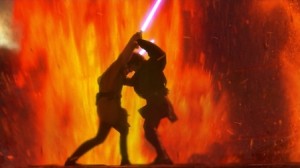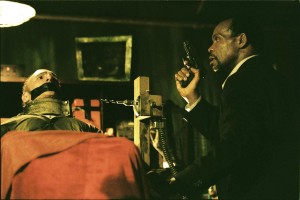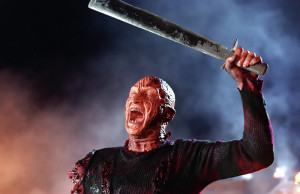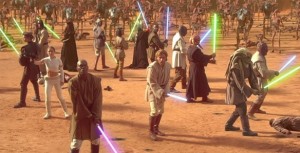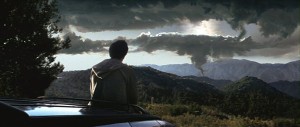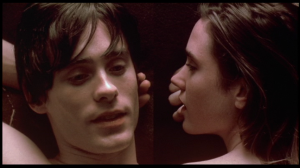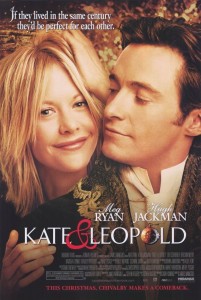The 40 Year-Old-Critic: Avatar (2009)
In The 40-Year-Old Critic, Venganza Media creator and host Arnie Carvalho recalls a memorable film for each year of his life. This series appears daily on the Venganza Media Gazette.![]()
Avatar is the highest grossing film of all time. Audiences loved the film, as did most critics. Yet in 2009 the film failed to excite me, my review was controversial, and to this day Avatar continues to give me a headache. To this day I also remember the buildup to that film’s release… and the aftermath.
I had heard rumblings about Avatar for years. James Cameron’s last theatrical film had been Titanic in 1997 — then the top-grossing film of all time — and after that massive success the director dropped out of the spotlight, focusing his time on a few IMAX documentaries. It seemed quite possible in my mind that Cameron might not ever make a film again, and with each passing year I paid less attention to the rumors that swirled about his next project.
It wasn’t until San Diego Comic-Con in 2009 that Avatar truly grabbed my attention. Signs showcasing the blue Na’vi aliens were everywhere, and all the buzz at the convention was about 20th Century Fox’s panel and the Avatar footage they would show.
My curiosity was piqued. I was a fan of Cameron’s films in the 80s and early 90s; the two Terminator films and Aliens are among some of my favorite movies. I was less thrilled with The Abyss and True Lies, and Titanic was the breaking point. The film was way too long in all respects, and while I thought it was competently made I never cared for it. As such, I wanted to see what the man who made Terminator 2 would do, but his later works prevented me from being excited.
As I wasn’t passionate for Avatar I never even thought it should be reviewed on Now Playing Podcast. That idea came from my co-host Stuart.
My memory is slightly fuzzy, but as I recall Avatar was the first film Stuart ever championed to review on the show.
Before 2009 Stuart had reviewed two only two movies for Now Playing. In 2008 I asked him to review Star Wars: The Clone Wars. I knew that compilation of episodes that Warner Bros. laughingly called a “film” was an atrocity that made The Phantom Menace look like The Maltese Falcon by comparison. Yet due to my primary podcast, Star Wars Action News, I didn’t want to eviscerate the film myself for fear of alienating any Star Wars fans excited for Clone Wars. Stuart had been writing reviews for another website for some time, and as he was one of my few friends who was not a fan of Star Wars, I felt he’d be perfect for the job.
Later that same year Stuart came to visit and we ended up seeing the Clive Barker film The Midnight Meat Train. Marjorie suggested we record a Now Playing review and I was shocked how much fun I had. Stuart’s knowledge of film plus my own horror fandom made that easily one of my favorite “early episodes” we recorded. But it was a one-off recording; there were no plans for there ever to be another. Still, I wanted to talk more horror with Stuart.
But Now Playing was not a priority for me in 2007 or 2008. During those years the show had languished; lack of regular content caused downloads to drop from the thousands to the tens. Several efforts to reignite the show had not caught on with listeners, but I enjoyed having an outlet to discuss movies when so inclined.
Things started to turn around in January 2009 when I was inspired to return to Now Playing to review the rebooted Friday the 13th, and it wasn’t enough to just do that one movie — I wanted to review the entire Friday the 13th series. And I wanted Stuart to join us.
He was hesitant. He didn’t love the franchise and wasn’t entirely sure what would be involved. Still, he agreed. Even with the lower caliber Friday entries, the recording sessions were fun. More, the audience was responding, and we started getting thousands of listeners again. As such, near the end of the Friday the 13th Retrospective we decided to continue going with Star Trek.
Things snowballed, and by late 2009 Stuart had been on dozens of shows discussing The Terminator, Halloween and more. Yet it seemed he was going along with the group. Even though there were series where he strongly liked early installments, the new releases didn’t excite him. The theatrical weekend-of-release recordings left him cold.
Until Avatar. After a long series of Halloween movie reviews Stuart wanted to do a one-off review for Cameron’s newest film.
Now it was my turn to resist.
I was hesitant for a number of reasons. First, Now Playing had tried for years to do weekend-of-release reviews, but it was the retrospective series’ that really clicked with listeners. Even in 2009 Marjorie and I had done a couple one-off reviews, but they didn’t reach a wide audience.
More, I was the editor for weekend-of-release recordings. Those shows take a bigger time commitment than any other. It’s easy to be a host on a series that doesn’t excite you — two hours of watching, two hours of recording, and you’re done. As the editor I’d have to spend another dozen hours, or more, editing and polishing the show. It’s hard to commit that amount of time for a film in which I had only mild interest.
But Stuart had been agreeable, reviewing some schlocky horror along the way. And he had already signed on for 2010’s Nightmare on Elm Street retrospective, a series I was ecstatic about. Now Playing scheduling is all about negotiation, so I agreed not only to Avatar but also to his idea of a Martin Scorsese/Leonardo DiCaprio team-up retrospective that would kick off 2010.
Plus Stuart followed film development and studio tracking far more than I did, and he knew how big Avatar would be.
Not to say I was totally resistant. More than wanting to be a team player and “give one up” for Stuart, as the film’s marketing started to hit I was curious. As I recall though, that curiosity was more muted, and it never reached a Spider-Man 3 level where I’d have been moved to podcast about the movie. But I did get swept up in the hype enough to give Avatar the “full Now Playing treatment” — special opening and closing credits.
In many ways Stuart was right. I never would have predicted Avatar would be the biggest film ever. That Cameron’s work could best even Titanic seemed unreal to me, yet it happened. And Stuart was also right that our review would get a lot of downloads; there was interest in the movie, and so it followed that our downloads were the highest we’d gotten for a one-off review at that time.
But I had to be honest in my review of the film, and I didn’t like it very much. Avatar was made by the James Cameron who directed Titanic, not the Cameron who directed The Terminator. The story was unoriginal and propagated the story trope of an indigenous people needing a white, male savior. The movie wasn’t terrible, but it was overly long and I never found myself enthralled with the world of Pandora. It seemed Cameron had spent too much time making documentaries and forgot how to tell a story.
But the technology impressed the living hell out of me. Cameron, at his best, is a filmmaker of tight, exciting action movies, but even when he’s not at his best he pushes the envelope of filmmaking. The Abyss, Terminator 2, and Titanic all represented giant leaps in computer-generated effects. With Avatar, Cameron not only used computer imagery, but he also advanced 3-D technology to a level I’d not seen outside of theme parks.
In 2009, 3-D films were still a novelty to me. Growing up after the boom of 3-D in the 50s I only got to see two films in that format: Jaws 3-D and Freddy’s Dead: The Final Nightmare (which only had the climax in 3-D). Yet the idea of being immersed in a film was exciting, so I went to see the Terminator show at Universal Studios with its amazing 3-D effects, I went to a museum to see the IMAX 3-D documentary Space Station, and I even went to see Spy Kids 3-D: Game Over in 2003 despite never having seen the first two Spy Kids films.
Slowly, 3-D films were returning, propelled by digital projection technologies. I had to travel hours to digital theaters to see such films as My Bloody Valentine 3D and The Final Destination just for the effects. They were good; gimmicky, but fun.
Yet none could hold a candle to Avatar, which not only had eye-popping effects but added depth to the frame. The 3-D was at times attention-grabbing, but at other times subtle. For the first time I saw how this new technique could really aid films in drawing viewers into the story.
That was what I thought leaving the theater in 2009. For this article I revisited Avatar on video (albeit in 2-D), and listened to the archived Now Playing Podcast review. I stand by everything I say; the movie was really impressive to look at, but also horribly dull.
The film ended up with one “Recommend” from Stuart. Marjorie — who had also co-hosted the Terminator reviews and thus was the natural choice to co-host more Cameron reviews — sided with me, and we gave two “Not Recommends.”
Reviews are a funny thing, no matter what you say, it pisses someone off. Every Now Playing host has received vitriol-filled e-mails, tweets, reviews, and more from listeners who disagree with their opinions. Rarely is this feedback constructive, filled with counter-arguments that support an opposing view. Usually the e-mails feel like notes from a kindergarten student, tantamount to saying, “You are a doodie-head,” though with many more four-letter words and, in some special cases, threats of physical violence.
Sometimes liking a film can be cause for this type of reaction, but it’s more common with negative reviews. No matter what title is being discussed, somewhere that film has an ardent fan whose feelings are hurt by having their film criticized. Superman IV, Halloween III, even Star Trek V, they all have their supporters.
While we received a few nasty-grams for our negative reviews of the Friday the 13th reboot, Rob Zombie’s Halloween II, and even 2009’s Star Trek, nothing prepared me for the backlash I would receive for giving Avatar a mild “Not Recommend.” The attacks came from all sources, but primarily nasty e-mails. Listeners not only said they were never listening to our show again, they wanted to be sure I knew it, and not just from watching server traffic. They wanted to make noise as they (supposedly) walked out the door.
Our audience only continued to increase throughout 2010, but the scathing, often personal, attacks let me realize that by putting myself out there and expressing my thoughts I was really opening myself up for a lot of negativity.
While that trend has continued — each host speaking unpopular truths — I’m happy to report the positive feedback from listeners far outweighs the negative, but in the midst of Avatar-gate there were times it didn’t feel that way.
Yet, for all the attacks I received in 2009 for giving Avatar a red arrow, I have to wonder; is there still the love for this film? It truthfully feels like that movie was a flash in a pan. I see the disc on Walmart movie racks, but I know of no one who regularly re-watches the movie. It’s not in rotation on cable, network, or pay television. I see no Na’vi cosplay at conventions, and rarely does Avatar show up on lists I read of favorite or best films.
If you still love, or even strongly like, Avatar, please let me know in the comments below. For while the studio talks of two, and now three, sequels in concurrent production, I simply don’t see the demand from the fan base. Actually, I don’t even see the fan base existing at all.
So in that regard I feel vindicated. Unlike Titanic, which was inescapable for many years after its release, Avatar seems forgotten.
But I am not above issuing a correction when due, and I did say something in our 2009 review that history has proven untrue. I stated Avatar was the best looking film I’d ever seen, with the greatest 3-D effects to date, and I stand by those thoughts. I continued, though, that the next year we’d see films with even better CGI visuals, and even greater 3-D, and in that I was dead wrong. Cameron is more than an artist, he’s a technician. He has both the will, and (thanks to his track record) the studio support, to linger in development and ensure the films he makes always reach new heights. Yet here we are, five years later, and no film has bested Avatar‘s use of 3-D in film. Cameron’s work is still my high watermark against which I measure all other 3-D.
More, it seems no filmmaker is even trying to achieve that result. Technical difficulties have kept many directors away from filming in 3-D. Joss Whedon had intended to shoot 2012’s The Avengers in 3-D, but while filming the Thor stinger scene he encountered numerous production delays caused by the cameras. As such, he abandoned the medium and chose to shoot in 2-D.
Disney then post-converted The Avengers to 3-D for theaters.
And that may be Avatar’s longest lasting, and worst, outgrowth — the 3-D cash grab. It was not just by popularity that Avatar became the world’s top-grossing film, much of that was due to inflated ticket prices. The general cost of movie tickets has been steadily rising for decades, but premium surcharges put on IMAX presentations and 3-D films boosted Avatar to even greater heights. Studios wanted to continue to reap those rewards. It took a year for studios to implement the change, but by 2011 almost every major motion picture released was in 3-D — the majority post-converted in order to make more money through higher ticket prices.
Recently it seems that audiences are wising up to this gimmick and realizing that, especially with post-conversion 3-D films, the effects are not worth the extra cost. Many articles I’ve read point to a decline in 3-D film popularity. But to this day, every time I go to theaters and pay a 3-D surcharge, and every time I leave the theater with an eye-strain headache due to a piss-poor 3-D post-conversion job, I know that is truly Avatar‘s legacy.
Perhaps Cameron will succeed in bringing Avatar back to the screens. Hopefully the story will be more original, and tighter. More importantly, maybe they will change Avatar‘s place in film history from “the film that popularized 3-D” to “the sci-fi fantasy saga of the 21st Century.”
Or perhaps I’ll give more negative reviews to dull films.
Time will tell.
But then again, perhaps the true, best legacy of Avatar was expanding Now Playing’s boundaries. It’s not often that we do one-off reviews, but Stuart’s correct insistence that we review Cameron’s 2009 epic exposed our show to new listeners and helped expand even the type of film we review. For that, I am grateful.
Tomorrow — 2010!
Arnie is a movie critic for Now Playing Podcast, a book reviewer for the Books & Nachos podcast, and co-host of the collecting podcasts Star Wars Action News and Marvelicious Toys. You can follow him on Twitter @thearniec
September 8, 2014 Posted by Arnie C | 40-Year-Old Critic, Movies, Reviews | 2000s, 3-D Film, 3D, 40-Year-Old Critic, Avatar, Enertainment, Film, James Cameron, Movie, Movies, Now Playing, Now Playing Podcast, Podcasts, Review, Reviews, sci-fi | 5 Comments
The 40 Year-Old-Critic: Iron Man (2008)
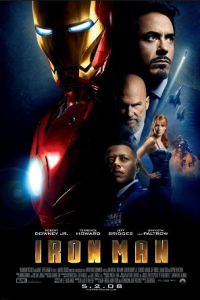 In The 40-Year-Old Critic, Venganza Media creator and host Arnie Carvalho recalls a memorable film for each year of his life. This series appears daily on the Venganza Media Gazette.
In The 40-Year-Old Critic, Venganza Media creator and host Arnie Carvalho recalls a memorable film for each year of his life. This series appears daily on the Venganza Media Gazette.
We truly live in the golden age of Marvel movies. In the past six years Marvel Studios (and now Disney) have set the standard for comic-based films, and racked up some of the highest-grossing hits of all time.
This year, the company proved how golden it really is with Guardians of the Galaxy, a film featuring a talking raccoon and his friend, the tree. On paper, that’s laughable. This movie shouldn’t have worked; the concept is so far removed from The Avengers that it conjures up memories of Howard the Duck (who even made a cameo).
But as I sit here typing this, Guardians has the designation of being 2014’s top grossing picture in the U.S.
It’s a wild success story that no one could have predicted — certainly I didn’t — back in 2008 when Marvel Studios released its first film: Iron Man.
As I detailed in my reviews of Superman and Spider-Man 3, I was a Marvel Comics fan in my teen years. At my peak I had several thousand comic books; long boxes stuffed with popular titles like Spider-Man, X-Men, and The Incredible Hulk, as well as Darkhawk, Ravage 2099, and Fantastic Four. Conspicuous perhaps by his absence, I didn’t own a single issue of Iron Man.
The character did make appearances in many comics I owned. Massive crossovers such as Secret Wars prominently featured the Armored Avenger. Yet none of those appearances made me feel like picking up an Iron Man comic. A businessman who pretends to be his own bodyguard in a suit of armor? The concept sounded pretty cheesy. The suit’s design, a garish red and yellow, also was a turnoff. He could fly. He could shoot lasers from his hands. And? Why would I want to read about that?
More, why would I want to see a movie about that?
The arm-chair studio moguls online and in magazines like Entertainment Weekly seemed to agree with me. Phrases like “B-list superhero (at best)” were used to describe Iron Man. It is hard to believe now, but just seven short years ago Iron Man had virtually no name recognition among the common public. Marvel had sold the movie rights to many its most well-known superheroes, including Spider-Man, Hulk, Wolverine and the X-Men, and those characters had gone on to star in their own pictures. Even other B-listers like Daredevil, Blade, and Ghost Rider had been picked up by other studios. What did Marvel have left?
They had Captain America, a man out-of-time goody-two-shoes. They had Thor, a Norse god that may have been even less well-known in his comic incarnation than Iron Man. They had The Incredible Hulk, who had a good history but a recent box-office disappointment thanks to Ang Lee’s Hulk. And they had Iron Man.
Yet Marvel had a vision. More, they had a plan. They didn’t release one film in 2008, they released two. They let it be known immediately that they were going to do on screen what they had done in their comics: create a shared universe where characters would cross over. The end game was announced before Iron Man was in theaters, Marvel wanted to assemble The Avengers.
I thought it was crazy talk. While, thanks to Harry Potter and Lord of the Rings it had become more common to have sequels in production, or even entirely filmed, before the first film was released. Even those seemed risky though, with pundits noting Lord of the Rings could have bankrupted New Line Cinema. Yet here Marvel Studios was going this route for its first features.
Iron Man didn’t excite me, but Marvel’s strategy sure got my attention. It was audacious, it was bold, and it was risky. I admired them before I ever saw a frame of the film.
Even crazier — they hired Robert Downey, Jr. to play Iron Man/Tony Stark. If you’ll recall, in the late 90s and early 2000s, Downey had a fairly toxic reputation in Hollywood. His well-publicized battle with addiction and his prison stints had branded him as unreliable. Worse, he was uninsurable — no company would put up a bond for the actor lest he again be arrested and his filmed scenes became unusable.
Despite his off-screen troubles, I had always been a fan of Downey. While I’d seen him in Weird Science and Back to School he first really caught my eye as someone to watch in The Pick-Up Artist, a film in which Downey is the only redeeming quality. I followed him for many years with Less Than Zero, Chances Are, Air America, hell I even watched Soapdish because he was in it. But two roles really defined Downey for me: his 1992 Oscar-nominated lead in Chaplin, and his role as a tabloid TV reporter in Natural Born Killers. But the more public his personal troubles became the more I felt he was an actor on the decline. I was really saddened by this — the man could act! From Two Girls and a Guy to U.S. Marshals to Kiss Kiss Bang Bang, I’d always been captivated by him.
That he was the star of Iron Man had me both worried and excited. On the one hand it seemed like on-the-nose casting — if I knew one thing about the Tony Stark character in comics it was that he was an alcoholic; if most people knew Downey for only one thing it was for his substance abuse problems.
The trailers with the rocking Black Sabbath track, Downey’s quick quips, the great action, and the effects — the film looked better than I expected; better than it deserved to look. Plus, rumors spread like wildfire that the film would include a cameo by Samuel L. Jackson as S.H.I.E.L.D. boss Nick Fury. By the time Iron Man was released, my curiosity was piqued.
Still, I was more interested in the second of Marvel’s one-two summer punch: The Incredible Hulk. I was a Hulk fan, he was the hero with name recognition; plus it had Edward Norton, an actor I believed was every bit as talented as Downey. But until Hulk came out I thought Iron Man could help me pass the time.
My expectations were low, but I was still there opening night to see Iron Man. I even drove 90 minutes to the closest new-fangled digital projector in the area.
The film, in short, rocked. I never expected to have so much fun in a superhero film. Movies like Blade, X-Men, and Batman Begins had seemed to say there was only one way to make a comic book movie, and that’s deadly serious. Iron Man eschewed that attitude with the flippant irreverence I’d expect from its main character. The movie did have its serious scenes, but the majority of the picture was filled with a kinetic energy and a constant sense of fun. I walked into the theater not getting Iron Man’s appeal; I walked out an Iron Man fan.
This was bolstered by Downey’s now-iconic performance. I couldn’t take my eyes off him. His jokes, his charisma, he owned this film. His line, “I am Iron Man,” was 100 percent accurate, for I couldn’t imagine this movie without him. Given the wide range of roles I’ve seen Downey portray I am hesitant to call this his best performance ever, but it is my favorite (with his 2008 follow-up Tropic Thunder a very close second).
Iron Man even brought Now Playing Podcast out of a brief retirement in 2008, and we followed up that short review with an even more extensive breakdown of the film for our Avengers Retrospective Series in 2012.
Yet, despite my love of the movie, I still thought Marvel’s overall strategy was ill-formed. Iron Man did well, Hulk did not. More, the only superhero film people seemed to remember from 2008 was Christopher Nolan’s The Dark Knight — a film that was more than a blockbuster, it was a cultural touchstone.
In 2008 it really seemed Marvel had lost the battle. More, they had no movies planned for 2009. Iron Man was a big enough hit to keep the wheels turning for Iron Man 2 in 2010 but I never thought Marvel could go the distance. Avengers seemed like a pipe dream.
Again, I bet wrong. Iron Man 2 built on the brand in 2010, and the following year saw two more Marvel films, Thor and Captain America: The First Avenger. Both did respectable business, but neither broke the $200 million domestic mark to be qualified as a blockbuster. They didn’t need to; Marvel was playing the long game, they were building a brand.
It paid off — big time. The Avengers took the world by storm. It almost seemed a rematch of Marvel versus DC as, that same year, Nolan returned with The Dark Knight Rises. Iron Man once again faced Batman, but this time Stark brought his friends and when 2012 ended it was The Avengers that had become the benchmark for comic book movies. Sorry, Batman.
Marvel Studios’ brazen gambit paid off in spades. Not only has the company become an unstoppable movie juggernaut, they have expanded their cinematic universe to weekly network television, to four different Netflix series’, and even drawn plans for up to three movies per year in the future.
Other studios now desperately try to ape Marvel’s success. After trying for 20 years to get Batman and Superman on screen together, next year finally brings us Batman v Superman: Dawn of Justice, with a list of superheroes that include Wonder Woman, Cyborg, and — according to rumor — Aquaman, the Flash, and others. DC is now playing catch-up to Marvel.
Even other studios with Marvel properties have tried to follow this formula, though to less success. The same year The Avengers was released Sony tried to build its own multi-chapter story with The Amazing Spider-Man. This year they announced that a Spidey universe of films is coming, including two spin-offs featuring villains — Sony is now grasping for whatever characters to which they hold rights. At 20th Century Fox, studio executives also bet big-time on their X-Men franchise, bringing back original director Bryan Singer to revitalize the series. The Marvel Studios tactic of ending each film with a “stinger” to tease the next picture is now so commonplace, audience members are afraid to leave the theater before the end credits are finished.
Yes, for the past 6 years movies have been following Marvel Studios’ formula. It all started with a big gamble that paid off: Iron Man.
As for me, Iron Man opened a door that had been cracked the year before with Spider-Man 3. The Marvel movies were really an exciting property to follow. My dormant comic fandom was back with a vengeance. Marjorie, knowing my love of Iron Man, bought me my first high-end Marvel collectibles: a Hot Toys “Mech Test” Tony Stark figure, as well as a Kotobukiya Iron Man statue. The door was opened and before long the podcast Marvelicious Toys was launched as a companion piece to Star Wars Action News, focusing specifically on Marvel collecting.
More, Marvel Studios’ films had me wanting to build up to The Avengers. Now Playing Podcast had been following, almost exclusively, the retrospective format in 2009 and 2010, but after seeing Iron Man 2 I pitched to co-hosts Stuart and Jakob the craziest, biggest retrospective yet: every Marvel movie ever. Up until then our series’ had all been of manageable length of a dozen films or less. It took a year of discussion. First, Stuart thought we should only do the six Marvel Studios films. Then he thought we should do the major franchises. Finally he agreed to all theatrical films, and we had started Now Playing’s Complete Marvel Movie Retrospective. Over time I was even able to find a back door — several 1970s TV movies had aired in theaters in foreign countries.
It put Now Playing on a path to greater success, as described in my review of Howard the Duck — our first review in that very long series.
Yet while I still ride the high Iron Man gave me in 2008, bolstered regularly by a new “fix” from Marvel Studios, I do wonder how long this will last. Movies are defined by trends; after Star Wars every studio fast-tracked their space films, but by the mid-80’s those had become passé; after Gremlins any script with tiny attackers, from Ghoulies to Critters was given the green light. The cases of Hollywood me-too-ism are legion, but they all have one thing in common: they end when the next big thing comes along.
I often ruminate on what that next trend will be, and when audiences will tire of the serialized cinema storytelling and prefer movies that provide a singular experience with no “to be continued…” at the end. I have no doubt that day will come, but I think we’re in for many more years of the Marvel Age of cinema before we get there.
Tomorrow — 2009!
Arnie is a movie critic for Now Playing Podcast, a book reviewer for the Books & Nachos podcast, and co-host of the collecting podcasts Star Wars Action News and Marvelicious Toys. You can follow him on Twitter @thearniec
September 7, 2014 Posted by Arnie C | 40-Year-Old Critic, Comic Books, Movies, Reviews | 2000s, 40-Year-Old Critic, Avengers, Batman, Captain America, Collecting, Comic Books, Comics, Enertainment, Film, Hot Toys, Iron Man, Marvel, Marvel Comics, Marvelicious Toys, Movie, Movies, Now Playing, Now Playing Podcast, Podcasts, Review, Reviews, Robert Downey Jr, sci-fi, Sideshow Collectibles, Spider-Man, Statues, Tony Stark, Toys, X-Men | Comments Off on The 40 Year-Old-Critic: Iron Man (2008)
The 40 Year-Old-Critic: Spider-Man 3 (2007)
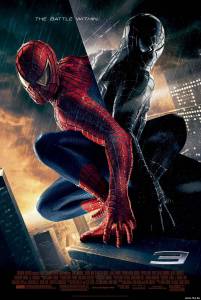 In The 40-Year-Old Critic, Venganza Media creator and host Arnie Carvalho recalls a memorable film for each year of his life. This series appears daily on the Venganza Media Gazette.
In The 40-Year-Old Critic, Venganza Media creator and host Arnie Carvalho recalls a memorable film for each year of his life. This series appears daily on the Venganza Media Gazette.
See a list of all reviews
Earlier this week, when I discussed Star Wars Episode III: Revenge of the Sith, I described how I tend to channel my excitement into creative venues. I’ve been doing it my whole life, whether that meant writing fan fiction, building model kits, customizing action figures — the point is, I like to build upon my imagination. In 2005 that drive led to the creation of the Star Wars Action News podcast.
Two years later, a near-equal level of excitement gave birth to an even larger idea that became Now Playing Podcast. The excitement was for Sam Raimi’s Spider-Man 3; the first film Now Playing ever reviewed.
I had been a longtime Spider-Man fan, from the 1970s Spidey Super Stories on The Electric Company to Spider-Man and His Amazing Friends and even Stan Lee’s daily The Amazing Spider-Man newspaper strips, but even I didn’t anticipate my own hype for this sequel. I barely caught the first Spider-Man film in theaters (its release in 2002, directly against Star Wars Episode II: Attack of the Clones, and my wedding, was much of the reason). I was more excited for 2004’s Spider-Man 2, but I wouldn’t say I was “hyped.”
But the bug bit me in 2007 — Venom had gotten into my system.
I started reading comics in 1990. I never got into them as a child; I simply wasn’t exposed to comics through friends or media. My Star Trek fandom drew me into the comics culture, because I wanted to read the “official” stories taking place after the events of Star Trek V: The Final Frontier. The first time I stepped into a comics shop the clerk tried to sell me Spider-Man No. 1, from the highly-acclaimed Todd McFarlane series.
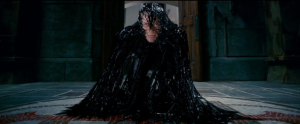
This tease ignited the fanboy in me.
I passed. I always thought the comics were just color reprints of the daily newspaper strip, until my longtime friend and Now Playing co-host Stuart started telling me stories about how Spider-Man changed his costume to one that was black-and-white. Incredulous, I didn’t believe him, especially when he told me the suit turned out to be an evil alien. In response, and to prove his point, he pointed me to a comic book store. I went back to read many of McFarlane’s Amazing Spider-Man back issues. Of specific interest were the stories that involved Venom, a muscle-bound baddie named Eddie Brock with whom the alien suit had bonded. Venom had all of Spider-Man’s powers, but none of his responsibility.
For years I read every Spider-Man comic, but I anticipated none as much as those that starred Venom. When Brock went from villain to anti-hero in his own series, Venom: Lethal Protector, I was even happier; I could now read about him every month!
I honestly wonder if I liked Venom even more than Spider-Man himself.
As a fan I read rumors about a big-screen adaptation of Spider-Man, but it languished in development hell for more than a decade. I remember reading a Wizard Magazine in 1992 that teased a James Cameron directed Spider-Man film starring Charlie Sheen as Peter Parker and using Terminator 2 special effects for the villain — Venom! I couldn’t have been more excited but, alas, that film never materialized. When Spider-Man did hit theaters in 2002 Sheen, Cameron, and Venom weren’t even under consideration.
Finally, after enjoying two Spider-Man films in theaters (as you can hear in the Now Playing Podcast Spider-Man Retrospective Series), word came that Raimi was finally getting to my favorite Spidey nemesis.
Venom was first teased at the 2006 San Diego Comic-Con. I wasn’t in the Sony panel, but friends excitedly described the scene of alien ooze landing on Eddie Brock (Topher Grace). That the scene took place in a church really upped my expectations — Raimi had been pretty loyal to the Spider-Man mythos thus far, and despite casting the wiry Grace as the muscle-bound Brock, it seemed he was continuing that trend with Venom.
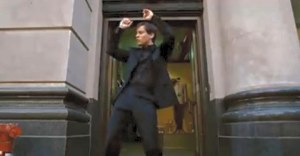
I’d seen the black outfit take Peter Parker to dark places in the comic…but never as dark as Maguire’s uncomfortable dance scene.
Venom, Raimi, and Spider-Man created a perfect storm of hype.
I am a collector by nature, and often I express my fandom through displays of movie memorabilia. It all started with my Star Wars toys in 1977, but from Superman to Gremlins to Ghostbusters to Star Trek, I’d always buy the trading cards, toys, and books for films I loved. Of course, Star Wars remained my primary focus — I bought every figure, vehicle, book, and game released.
By the year 2000 my townhouse was a crowded toy box, full of Star Wars toys, but also X-Men movie figures, Spider-Man toys, McFarlane Toys’ Movie Maniacs series’ Leatherface, Freddy, and many more. But in 2001 I quit my job and became a full-time student, and with that drastic reduction in income came a drastic reduction in collecting. I actually sold most of my toys and narrowed my focus down to my first love — Star Wars. Even as my career started to take off, my income increasing, I was never tempted to return to collecting anything but Star Wars until Spider-Man 3.
By 2007, Star Wars Action News was heard by tens of thousands of listeners every month, and hundreds congregated on our forums to discuss the toys. Surprisingly, many of those fans were also swept up in the excitement to see Raimi’s next Spider-Man film. When I mentioned on the podcast that I was drawn to — but couldn’t allow myself to buy — a particularly cool Venom figure sold by Sideshow Collectibles, these listeners came to the forums en masse to encourage my spending! Some even tried to take up a collection to buy the $80 figure for me; an act of generosity I could not possibly accept.
The flames of my Spider-Man 3 excitement were fanned by Star Wars Action News listeners, and that combination caused me to move on an idea I’d had for some time: a movie review podcast. The first movie we’d review would be Spider-Man 3, obviously.
It wouldn’t be a stretch, my wife (and co-host) Marjorie and I had already reviewed one movie together, Snakes on a Plane, the year before.
Coincidentally, another Marvel character first planted the seeds in my head that I should launch this show. Coming out of 2007’s Ghost Rider Marjorie had me almost doubled over with laughter as she lambasted the Nicolas Cage film. Not only were her observations on point, they were quite amusing. I knew many of our listeners loved Marjorie’s color commentary, and I thought that if I’d had a microphone on us walking out of Ghost Rider we’d break download records.

Despite the film’s numerous flaws, the CGI work on Sandman was impressive, and moving.
But I was daunted. Movie review podcasts were a dime a dozen. Anyone with a microphone seemed to be reviewing movies. With Star Wars Action News we’d made a big splash in the Star Wars community — a big fish in a tiny pond. Yet, even with that success I knew that we’d be out of our comfortable pond and thrust into an ocean of movie podcasts. I wasn’t sure how to make us stand out, and so I never acted on it.
More, SWAN had gone from a one-day-per-week hobby to a very time-consuming new career. Two hours of recording became 10 hours of editing, and then toy photography and travel — suddenly I was spending more time on podcasting than I was on teaching my college courses. Plus, teaching was my second job; I also had a full-time day job. With all of these commitments the thought of doing another podcast regularly was overwhelming.
Still, the seed had been planted, and my excitement for Spider-Man 3 turned it into action. Marjorie came up with the name, taken directly from the screen of her iPod that always said at the top, Now Playing.
It’s laughable now as I spend 30 or more hours per week on the show, but I originally thought Now Playing Podcast wouldn’t take much time. I figured we’d stick to my first idea and take the portable recorder (the one I’d purchased for the Samuel L. Jackson interview) to the theater and when the movie was over I’d have a microphone to capture our initial reaction. Marjorie and I went to the movies nearly every week, so we could have a spoiler-free review with just a few minutes of recording. I’d release it unedited, just add music, and be done.
As for the way to differentiate ourselves from the thousands of other podcasts? That would take me a couple more years to really figure out. In the meantime we had Marjorie and a built in audience for Star Wars Action News.
Deciding to launch Now Playing on the same day as Spider-Man 3’s release had two profound effects. First, my excitement for the next Spidey film had an outlet that didn’t involve buying collectibles. I was preparing our own launch of a podcast, so my time and money was spent getting domain names and setting up web pages (Though I was visiting Burger King more than usual to get their Spider-Man 3 kid’s meal toys — the Venom still eluded me).
Second, the anticipation for May 4, 2007 increased 50-fold — that was the day I’d get to watch Spider-Man and we’d launch our newest podcast!
My excitement level was so high we actually took that afternoon off work. There were no midnight shows, but we were there for the first matinee of the day. It was time to see Venom fight Spider-Man, and classic Spider-Man bad guy Sandman (Thomas Hayden Church) would be in there somewhere as well.
In my mind I felt I knew how the movie would be paced. The trailers had shown Spider-Man fighting Sandman while wearing his black suit. I thought for certain it would follow the structure of the original film, with the first half largely about the origin story, only this time it would be the origin of the black suit (again with Sandman in there somewhere). Then, I assumed the second half of the picture would be about our hero battling his arch-nemesis, only this time instead of Green Goblin it would be Venom.
The more I heard about Sandman being the main baddie in this film, though, I started to form a back-up theory. The trailers never showed Venom outside of the church, so I thought this entire film could be a setup for Venom, who would return as the main bad guy in Spider-Man 4.
No matter what, in Raimi I trusted. From Evil Dead to Army of Darkness, Darkman, and more, he had proven time and again to be a director with style and vision (that late 90s period including For the Love of the Game notwithstanding).
We got to theater early, after an obligatory trip to Burger King to try and get that damn Venom toy. No luck.
I can still remember being so excited I was practically vibrating in my seat. The film started, the score played over an opening credits montage reminding us of the first two films. Little did I know this would be the high point of the movie for me — thinking of the earlier, better films.
The introduction of the alien symbiote that became Spider-Man’s black suit was the opening scene, and completely convenient. It just happened to land near Peter Parker and take him over. No reason why, it just happened.
Faith was restored with the introduction of Sandman, Church having bulked up for the role and really looking like the comic book character come to life. The CGI effects during his transformation marked a new standard for humanity conveyed by computer animation.
But that was quickly lost by the contrived retcon tying Sandman to the death of Spider-Man’s Uncle Ben, and a subplot involving Peter Parker’s love life.
I won’t rehash the entire review again. You can hear our full, detailed, scene by scene review in the Now Playing Podcast archives. The disappointment you’ll hear in my voice mirrors my thoughts sitting in that theater. During that theatrical experience I realized not only was I watching a movie that was not very good, but that Now Playing’s first review would not be very positive. I had hoped for the show to be a celebration of Raimi’s film — the orgasmic climax after five years of build-up. Instead, we would have to be honest and discuss how everything — from the plot to the acting to the score — was not only far below my expectations, but also not very good at all.
No matter the quality of the movie, Now Playing Podcast had arrived. Star Wars Action News listeners and forum members were anxiously awaiting the review. So we went to the car and, raw from the experience, recorded our thoughts. We sat in the car, Spider-Man toys from BK in the back seat, and gave our initial reactions. I tried to temper my disappointment, but when I listen to that show I can hear the sound of a heart breaking.
In the years since I’ve come to focus on some of the better parts of the movie. The effects are mostly top notch, Topher Grace adds needed energy to the cast, and some of the jokes are winners. With the dour nature of The Amazing Spider-Man reboots, I even sometimes finding myself actually wishing for some of the spirit Raimi put in all of his films… even Spider-Man 3.
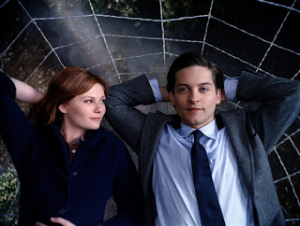
The tangled web that is Peter Parker’s love life would never straighten out; after Spider-Man 3 Sony decided to reboot without Raimi at the helm.
Yet from that bad movie experience something good did come — Now Playing. It would take years for me to realize that. Despite my best intentions, the show went from being recorded on the run to being done in the studio; it went from unedited to lightly edited to full edits. The time commitment was growing, and the listenership wasn’t. We were now one very tiny fish in an ocean so overpopulated that most shows suffered from listener famine. Without listener involvement the show became neglected, and the fewer shows we did the fewer listeners we had when we would put out new reviews. For a while we even gave up hosting altogether.
It wasn’t until 2009 when another movie, another hype machine, got me going: the Platinum Dunes remake of Friday the 13th. Then I had the idea of the Retrospective Series and a three-person rotating cast of hosts. The hype for that movie also ended in disappointment, but we had finally found the format that made our show stand out.
Today Now Playing is a regular show in iTunes’ Top 10. I’ve met hundreds of listeners in person and talked to thousands through social media. Each person with whom I interact is an experience I cherish, and it’s stunning to think none of this would have happened if it weren’t for Spider-Man 3.
And as for my resistance to collecting Marvel, Spider-Man 3 helped me stave that off… for a couple more years at least. As anyone who’s heard my Marvel collecting podcast, Marvelicious Toys, knows, I have now fully embraced it and enjoy it as a smaller side-collection to my primary Star Wars collecting.
Tomorrow — 2008!
Arnie is a movie critic for Now Playing Podcast, a book reviewer for the Books & Nachos podcast, and co-host of the collecting podcasts Star Wars Action News and Marvelicious Toys. You can follow him on Twitter @thearniec
September 6, 2014 Posted by Arnie C | 40-Year-Old Critic, Amazing Spider-Man TV Series, Comic Books, Movies, Reviews, Television | 2000s, 40-Year-Old Critic, Collecting, Comic Books, Comics, Enertainment, Film, Marvel, Marvel Comics, Marvelicious Toys, Movie, Movies, Now Playing, Now Playing Podcast, Podcasts, Review, Reviews, Sam Raimi, Sideshow Collectibles, Spider-Man, Spider-Man 3, Star Wars, Star Wars Action News, Toys | Comments Off on The 40 Year-Old-Critic: Spider-Man 3 (2007)
The 40 Year-Old-Critic: Snakes on a Plane (2006)
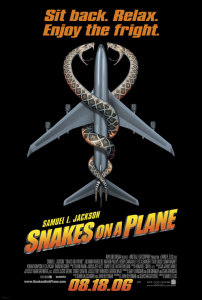 In The 40-Year-Old Critic, Venganza Media creator and host Arnie Carvalho recalls a memorable film for each year of his life. This series appears daily on the Venganza Media Gazette.
In The 40-Year-Old Critic, Venganza Media creator and host Arnie Carvalho recalls a memorable film for each year of his life. This series appears daily on the Venganza Media Gazette.
As I discussed in yesterday’s The 40-Year-Old Critic entry, I began my podcasting career in 2005 with the Star Wars collecting show Star Wars Action News; launched shortly after the release of Star Wars Episode III: Revenge of the Sith.
It had seemed like an easy enough hobby, we just record for 30 minutes each week.
However, the reach exceeded our every expectation, and in February 2006, we realized that recording from home wasn’t enough. All of the new Star Wars action figures and statues that would be released in 2005 had been revealed at Toy Fair International in New York City — and we weren’t there. We had our friends Pete and Chuck from the website Jedi Temple Archives call the show and share the news, but we knew we had missed out.
Pete and Chuck also told about the huge Lucasfilm and Hasbro presence at San Diego Comic-Con. New toys would again be revealed at the summer convention, and we felt Star Wars Action News should be there to cover it.
Marjorie and I had become more experienced con-goers since our first trip to Star Wars Celebration II for the release of Attack of the Clones, but we had never flown to an event. Airline tickets were expensive. Still, we had a show, and we needed the toys. Soon tickets were purchased, press passes obtained, and we were going to SDCC.
Then things got interesting.
As registered press for the convention, Marjorie and I started getting numerous e-mails from various companies seeking exposure. From toymakers to authors to movie studios, we were invited to exclusive events and given opportunities to interview total strangers.
Then came the e-mail that gave us the opportunity to interview Samuel L. Jackson and others for the upcoming film Snakes on a Plane.
I had heard about Snakes on a Plane but paid it little attention. Entertainment Weekly had written several articles about the silly movie with the overly-literal title. From the name alone hundreds of fan websites had sprung up. Despite its premise, the film had a groundswell of good buzz and the film’s producers wanted to capitalize on press coverage at the convention. With Jackson being a vital presence in the Star Wars prequels I thought an interview would certainly be of interest to Star Wars Action News listeners.
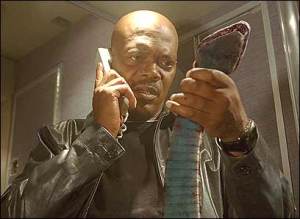
I like to imagine this is Jackson calling his agent wondering how he got on this Plane.
It seemed too good to be true. Jackson was an A-list star; I’d been podcasting for 9 months. I couldn’t believe it would actually happen. I told absolutely no one — after all, if it fell through I didn’t want to be mocked or thought of as a lying braggart. But I prepared: I bought a high-end digital audio recorder and I researched the film to be as informed as possible going in.
Yet the entire event could have been called San Diego Snakes-on-a-Plane Con. On the exhibit floor was a giant booth that was shaped like a snake, yet inside the mouth it had the feeling of a cramped airliner. The music video for Cobra Starship’s “Snakes on a Plane (Bring It)” was omnipresent (and I strained my eye every time it played for a glimpse of Maja Ivarsson’s nipple). We had gone to the convention with some friends who had just discovered the Badger Mushroom song, and so throughout the convention we’d regale each other with the refrain, “Snaaake! It’s a snaaake!” Our friends even brought rubber snakes to the convention as practical jokes.
I was swept up in the utter hype for Snakes on a Plane. I couldn’t wait for them to “Bring it.”
Sure enough, the next thing I knew I was in my first press roundtable interview. Jackson was the biggest star at the event, but it turned out there were four interviews in play. First, we interviewed director David R. Ellis, who I knew from his work on Final Destination 2. The other reporters at the table seemed disinterested and I got to ask a few questions.
Then we talked to the film’s snake wrangler Jules Sylvester. He wore an amazing serpent as he talked about the challenges of dealing with more than 450 snakes on set.
Finally, Sam Jackson visited our table.
Now the other reporters had perked up, and because I was still unaccustomed to the rhythm of the roundtable, I had to work hard to get questions in. I wasn’t entirely new to interviews; I had done many for journalism classes, and interviewed Star Wars collectors and authors on the show. But this was an A-list star. Jackson was there and actually joked with me a bit. It was surreal. He even gave me an autograph on a Star Wars book.
Finally the last interviewee came, Keenan Thompson, who Marjorie knew primarily for his work on Saturday Night Live. I got a couple of questions in there as well.
Leaving the interviews I realized I had far more content than I had thought. While the Jackson interview would be of some interest to Star Wars fans, the rest of the interviews were full of good information, though I knew they had no place on Star Wars Action News. Early feedback from Star Wars listeners was that they did not care for bad language, and so I figured the audience crossover between an R-rated reptile disaster film and Star Wars Action News was minimal.
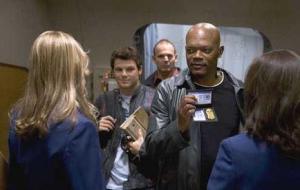
I’m not sure if a movie titled Snakes on a Plane needs more plot than, well, snakes on a plane. Yet this film also gives us a crime story to explain…sort of…how the snakes, and Sam Jackson, got on that plane.
But with four great interviews in the can I decided to start our second podcast, Snakes on a Podcast. It was a limited show, with only five episodes. The first four would lead up to the release of the movie and each would contain one interview. Then, for the fifth show, Marjorie and I would review the movie.
We publicized the show heavily on Star Wars Action News and it got a decent number of downloads. More, anticipation was high for our review; people wanted to know if we thought Snakes on a Plane was worth seeing.
Marjorie and I went to see Snakes opening night in August 2006. We had pre-purchased tickets, the Internet and Comic-Con hype convincing us it would be a sold-out show. It wasn’t.
More, the movie itself wasn’t very good, and we knew it in the theater. It wasn’t terrible, we had seen far worse that year, yet we had hoped for a pulpy B-movie full of laughs and fun. This was long before there was a Sharknado or Piranha 3D, but it was those films’ campy vibe that we hoped Snakes on a Plane would capture. There were moments of that in the film, but they were few and far between. The studio had initially made a PG-13 movie, then went back and added in scenes for the R-rating based off Internet fan demand for the line, “I want these motherfucking snakes off this motherfucking plane.” Those added scenes were what we wanted, that line was legendary, but in between moments of fun were long stretches of stupidity.
You can hear our thoughts, recorded minutes after leaving the theater, in the archived Snakes on a Podcast show. It is the first movie Marjorie and I ever reviewed in podcast form, and is the precursor to Now Playing Podcast, a show we started nine months later.
While the movie failed to meet our expectations, the theatrical viewing didn’t. It was an experience akin to The Rocky Horror Picture Show. While the theater wasn’t packed, everyone there was a built-in fan and the energy of the audience made for a good time. I have watched Snakes once since that theatrical viewing and it is clear that without the fans surrounding us there was little fun to be had.
Snakes on a Plane will always hold a special place in my heart. Not only was it the first time I ever felt like a real reporter for a podcast, it also is one of the last movies to consume San Diego Comic-Con. In the 2000s the complaints were that SDCC was no longer about comics; the fans had come for the movies. That was certainly true in my case. Hollywood studios saw SDCC as an opportunity to push genre movies to greater success, and spent hundreds of thousands, sometimes millions, of dollars at the convention trying to do so.
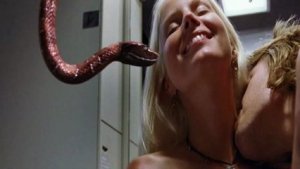
One of the films better, funnier scenes–added later to ensure an R-rating.
Despite the impressive imprint the movie had on the convention floor, Snakes on a Plane fizzled at the box office. Since 2006 a single film has always been pushed at the convention, from Hamlet 2 to Balls of Fury to Scott Pilgrim vs. the World, and they all failed to meet heightened studio expectations. Now it seems film studios have all but abandoned Comic-Con. The giant, custom booths that used to grace the floor are mostly gone. While stars still fly in to host one-hour panels, the convention has morphed into a showcase of genre television shows like Doctor Who, Game of Thrones and Arrow.
Yet each year I hope for another Snakes on a Plane-type experience, another extreme booth attempting to immerse fans in the world of their movie. It may not happen again, but at least I got these motherfucking snakes on this motherfucking Plane.
Tomorrow — 2007!
Arnie is a movie critic for Now Playing Podcast, a book reviewer for the Books & Nachos podcast, and co-host of the collecting podcasts Star Wars Action News and Marvelicious Toys. You can follow him on Twitter @thearniec
September 5, 2014 Posted by Arnie C | 40-Year-Old Critic, Conventions, Movies, Now Playing Podcast, Podcasts, Reviews | 2000s, Cobra Starship, Comedy, Enertainment, Film, horror, Movie, Movies, Now Playing, Now Playing Podcast, Podcasts, Review, Reviews, Samuel L Jackson, San Diego Comic-Con, SDCC, Snakes on a Plane | 1 Comment
The 40 Year-Old-Critic: Revenge of the Sith (2005)
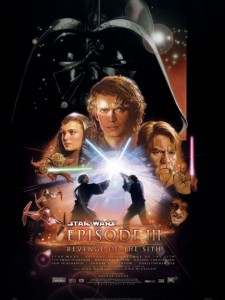 In The 40-Year-Old Critic, Venganza Media creator and host Arnie Carvalho recalls a memorable film for each year of his life. This series appears daily on the Venganza Media Gazette.
In The 40-Year-Old Critic, Venganza Media creator and host Arnie Carvalho recalls a memorable film for each year of his life. This series appears daily on the Venganza Media Gazette.
Star Wars’ greatest legacy may not be the (now endless) sequels, or the billions of dollars in box office revenue, or even the tens of billions of ancillary revenue the franchise has generated for Lucasfilm (now Disney). No, the longest lasting impact of Star Wars may be the people inspired by that film saga to go on and create themselves.
Filmmakers as varied as Jon Favreau, Damon Lindelof, and Eli Roth have all cited Star Wars as an important inspiration to their works, as have numerous authors, artists, game designers, and more.
In 2005 Star Wars inspired me as well… to become a podcaster.
By the time Star Wars Episode III: Revenge of the Sith was released I was pretty far-gone in terms of my fandom. Any lull I had experienced from 2000 to 2002 was long gone. My 2-bedroom townhouse had become a virtual Star Wars shrine with toys, prop replicas, and other various bric-a-brac on display in every room. As much due to my collection as it was a desire to build equity, Marjorie and I eventually left the rental property behind and moved into a home specifically selected for its ability to handle and display my Star Wars collection.
I had gotten three Star Wars tattoos since Attack of the Clones was released, including a Yoda that was based on the art in Genndy Tartakovsky’s Clone Wars micro TV series that bridged the story between Episode II and III. I was the ultimate Star Wars consumer — if it had a Star Wars logo I either bought it or put it on a long list to buy. I even, much to the amusement of the Target clerk and the embarrassment of my wife, bought a pair of Star Wars underwear intended for small children. To outsiders it was an undergarment, but to me it was a collectible.
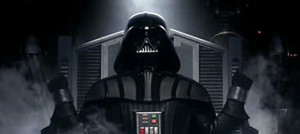
The birth of Darth Vader was the moment fans had waited 28 years for.
The excitement grew as we drew close to Revenge of the Sith’s May 2005 release date. The premiere was May 19 at 12 a.m., and I took the day off of work to sit outside the theater trying to get the best seats. Though I arrived at 10 a.m., I was not the first in line.
Coming off the high of the Star Wars Celebration III convention we attended in April, Marjorie and I had prepared line party events, including trivia, prizes, and music. I rolled up in my convertible with two 12-inch subwoofers in the trunk and blasted dance mixes of Star Wars themes. It was a party, and a blast.
I did have to leave the party for a couple hours to teach class — which I did wearing a Darth Maul tie.
What about the movie? It was far from an afterthought in all the festivities, it was the main event. The conventions, the toys, the party, they were all ways to express our fandom and excitement for the upcoming release. But when I sat in that theater the early morning hours of May 19 I was enthralled. Instantly I knew this was the best of the Star Wars prequels, by a long shot. It was the first of the new trilogy to have emotional weight. Plus it had great action, exciting new characters, and even succeeded in besting The Phantom Menace by having the best lightsaber fight of the entire series. I had high expectations for Episode III and the film lived up to them.
I lived on a euphoric high for weeks after seeing Revenge of the Sith. I went several times in local theaters, not out of a sense of obligation as I did with Phantom Menace but because I wanted to enjoy the film again. Then Marjorie and I drove to Chicago to see the film digitally with Stuart, my Now Playing Podcast co-host and longtime friend.
My Star Wars collecting went to even greater heights. Every day during our lunch hour Marjorie and I would go on a toy run, visiting one or more stores looking for new Star Wars toys.
Weeks passed, though, and while my fandom never wavered the anticipation turned into a feeling of melancholia. I had been looking forward to the Star Wars prequels since they were first officially announced in 1993 (in, of all things, a Star Wars screensaver). For twelve years I’d always had the next Star Wars film to which I could look forward. With the prequels done I wondered if I would ever again experience that level of anticipation.
To continue to experience fandom in new ways I read more Star Wars novels and comics, and visited websites and online forums. There I saw repeated mentions of something called a “podcast.”
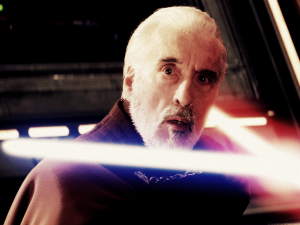
Still a better ending than Christopher Lee got in the Lord of the Rings series.
Being a tech head and, at that time, a college professor of Computer Science, I had heard of podcasting. I never understood the appeal; I was no fan of talk radio. More, I didn’t have an iPod, preferring the Creative Labs Nomad player. Yet now I saw there were podcasts discussing Star Wars, so I listened, and was excited. In my daily life I knew no Star Wars fans other than Marjorie, but on these shows were fans just like me, and they spent hours each week talking about nothing except Star Wars! Even more impressive, the Canadian podcast Star Wars En Direct even had Star Wars authors on the show to discuss their books.
I not only listened to the new podcasts, I went back and consumed the archives of many of these shows. Yet one thing frustrated me; while there were podcasts about Star Wars books, movies, and comics, none existed to talk about Star Wars collecting. Slowly the idea dawned on me… I should do my own.
I had a background in audio production. My desire to entertain, inspired by Pump Up the Volume, had sent me to study Mass Media Communications as an undergraduate. I was a radio DJ, and in my spare time experimented with digital audio, including rudimentary audio editing. As time went on I experimented in other computer multimedia, including video editing. I had the basic skills to do it, and just a few hours of research showed me all the technologies I would need to make it happen.
I also had my own website. My career goal had been to become a video game designer, and to build my resume I created a site reviewing PC games new and old.
So on Sunday, August 28, 2005, a little more than three months since Revenge of the Sith had visited theaters, I was inspired to create my own Star Wars podcast. I will never forget the conversation I had with Marjorie that Sunday morning.
“What plans do we have today?” I asked.
“Nothing,” she replied. It was a rare day that we had no obligations.
“Do you want to help me make a podcast?”
“Sure.” Then, after a moment, she asked “What’s a podcast?”
Within a few hours I had dug some old microphones out of a tote in my closet, installed the necessary audio editing software, and we were off. I didn’t know if anyone would listen, though I hoped they would. No matter what, though, I knew we’d always have the designation of having done it first.
That day Star Wars Action News was born.
I eventually learned that people did listen. I had reached out to several of the Star Wars websites and podcasts I’d read as a fan, and they actually posted about our show. I received immediate feedback, and that first week we had more than 50 downloads. The very next weekend I was at Best Buy to purchase better microphones and take some of that feedback to improve the show.
Tens of listeners became hundreds. Hundreds became thousands. Our show was a success. And while it was not earning money, I had finally found an outlet for my dream of entertaining people. Sure, I worked days at a bank, nights at a college, but on weekends I was a Star Wars commentator and collector.
That one podcast led to another… and another… and another. Marjorie and I have since traveled the country as invited Star Wars experts to speak at conventions. We have taken the mentality of throwing a Star Wars line party and grown it — at the last Star Wars Celebration we threw a party for almost 500 listeners and friends. Plus every year at San Diego Comic-Con we host the Star Wars Fan Breakfast for a sold-out crowd.
Most importantly, though, new friendships were formed. Marjorie and I met people near and far thanks to the reach of our Star Wars podcast. Now I had friends with whom I could chat about the saga, in addition to the regular show discussing my collecting.
And, of course, you’re probably reading this specifically because of Star Wars Action News. After all, without Star Wars Action News there’d be no Now Playing Podcast, the movie review show Marjorie and I started in 2007 and, with years of nurturing and attention, has grown to have an audience that even exceeds that of our cardinal show.

Darth Maul take note: lightsaber fights mean more when there’s a background between the characters.
These days it’s common for me to say “My life is weird.” I think this when I attend press events to interview the stars and directors of Leprechaun: Origins. The thought crosses my mind when I’m having a normal day at work and a piece of fan mail appears on my phone. I say it out loud when I see lines of people anxiously waiting to get into an event I’m hosting, just as I was anxious to see Star Wars in theaters. I’ve had the tremendous fortune to do things, meet people, and go places that many only dream of. I don’t take any of that for granted, but I always acknowledge that it’s a path I was inspired to take because of Star Wars Episode III: Revenge of the Sith.
Tomorrow — 2006!
Arnie is a movie critic for Now Playing Podcast, a book reviewer for the Books & Nachos podcast, and co-host of the collecting podcasts Star Wars Action News and Marvelicious Toys. You can follow him on Twitter @thearniec
September 4, 2014 Posted by Arnie C | 40-Year-Old Critic, Movies, Now Playing Podcast, Podcasts, Reviews, Star Wars, Star Wars Action News | 2000s, 2005, 40-Year-Old Critic, Anakin Skywalker, Collecting, Enertainment, Film, George Lucas, Movie, Movies, Now Playing, Now Playing Podcast, Obi-Wan Kenobi, Podcasting, Podcasts, Revenge of the Sith, Review, Reviews, sci-fi, Star Wars, Star Wars Action News, Star Wars Celebration, Toys, Yoda | 1 Comment
The 40 Year-Old-Critic: Saw (2004)
![saw-poster[1]](https://venganzamedia.com/Gazette/wp-content/uploads/2014/09/saw-poster1-210x300.jpg) In The 40-Year-Old Critic, Venganza Media creator and host Arnie Carvalho recalls a memorable film for each year of his life. This series appears daily on the Venganza Media Gazette.
In The 40-Year-Old Critic, Venganza Media creator and host Arnie Carvalho recalls a memorable film for each year of his life. This series appears daily on the Venganza Media Gazette.
During the last decade, much of our national conversation was centered on torture, both in current events and entertainment.
We’d read headlines about waterboarding and rectally-inserted broom handles, leaving us questioning the purpose and moral justification for torturing prisoners of war. Then, when we turned the page to the Entertainment section we’d read about reality show contestants undergoing some form of painful humiliation for fame; while at the multiplex, a new sub-genre of film was emerging: torture porn.
The term was coined by New York Magazine writer David Edelstein in 2007, but his christening of the brand name came after the release of Saw, the film that put torture porn in front of the masses and defined the horror experience of the first decade of the 21st century.
With torture surrounding us in real life why would audiences pay money to see make-believe torment on screen? I think Americans are comfortable taking horrible scenarios and making them “safe” through fiction. During the September 11 attacks we heard stories about people so panicked by the oncoming fire that they jumped from the high windows of the Twin Towers. Their terrible choice was a nightmare for our nation, that thought of having to either burn or leap to your death. Yet with films like Saw writers and directors took that same life-or-death choice and, because it was a movie, made it safe.
With these films we in the audience could both sympathize with the tortured, while also desensitizing ourselves to the acts on screen.
Perhaps we needed fictional torture to help us accept what the nation was experiencing?
Or perhaps we just wanted to push the boundaries of experience a little further through film?
I know I was looking for something new in horror. After 1999’s successful The Blair Witch Project it seemed Hollywood was smitten with low-budget ghost stories. Recycled J-Horror found success, praised by audiences and critics. I saw those films, but I continued to seek something more; something that was more dangerous than a PG-13 rating would allow, a movie that would push my boundaries the way Hellbound: Hellraiser II had in the 1980s. I wanted more than a bit of spooky suspense found in films like The Ring and The Grudge. I wanted a visceral feeling of life stretched to its most extreme limit.
I had no idea that’s what I would find when I watched Saw.
The film was low-budget — barely more than $1 million — and made by filmmakers who were inspired by the scares Blair Witch delivered, despite that film’s smaller cast and even smaller cost. Saw creators James Wan and Leigh Whannell started by making a 30 minute proof-of-concept film. Its effectiveness helped them raise the money they needed to hire a cast of accomplished actors, including Danny Glover and Cary Elwes.
The story seems simple enough — two men are chained up together in a room, and a dead body separates them. They must uncover clues, or saw off their own feet, to escape. Yet, while keeping a small scope, Whannell’s script created the first iconic horror villain of the 21st Century: “Jigsaw” John Kramer. Played by Tobin Bell, Kramer was a man dying of cancer. With little time remaining he begins to set intricate traps for people to help them live the rest of their life to the fullest — or die trying to escape.
As Jakob, Marjorie, and I mentioned in our 2009 Saw Retrospective Series, the concept of Jigsaw was not terribly original. This mastermind is merely an iteration of John Doe from Seven, but with a dash of the self-fulfillment agenda of Fight Club’s Tyler Durden. After all, Jigsaw’s trap of making a suicidal man cut himself is not that different than John Doe’s punishment for “Lust”; death by intercourse with a bladed phallus.
Yet, despite the similarities, there is one key difference: in Seven we found almost all of John Doe’s victims after the fact. When Seven‘s main characters, two police detectives, discover “Sloth” he’s already wasted away, and “Pride” is already dead. In Saw the cast has expanded; our main characters are the victims of the trap and we get to watch them faced with their tests.
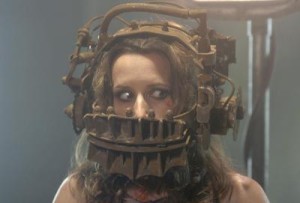
Shawnee Smith’s character Amanda escaped this trap to appear in five more Saw films.
More than just the two men in the room, the story grows to include more victims. Even for those introduced after an encounter with Jigsaw we still get to witness their torment in flashback. These scenes are myriad, from a woman in an iron collar that will tear her skull apart to a man, covered in napalm, having to hold a candle to read writing on a wall.
It’s not just that these victims were going to die in brutal ways (that was de rigueur for horror films since The Texas Chain Saw Massacre), but Saw upped the stakes by combining the suspense of impending horror. It was no longer just a killer behind the door, now there is a ticking clock and when it reaches zero someone will die, and in their last seconds they will harm themselves or others trying to escape.
These types of torment made waterboarding actually seem safe!
Though the creators of Saw would later claim the film was not torture porn, it was clearly the template for the dominant horror movement of the mid-2000s. Saw progressed through the scenes with characters put in increasingly more complex and convoluted traps, and I had the visceral reaction I’d sought. This movie did not scare me as Blair Witch did, but it repulsed me. I would flinch every time the next test came, knowing that the pain inflicted on the characters was fictional, but yet it hit home just the same.
The best part of it was that I was repeatedly asking the question: what would I do in those situations? Would I be able to cut off my own foot to escape a room? Could I kill a man in cold blood if the result was saving my own life? Could I take the pain of the razor cuts and escape the other side? And the absolute worst: could I shove both my hands in a shit-filled toilet to try and find a key?
Yet, a decade later I look back and wonder if subconsciously I made the connection between Elwes’ character, chained in a dirty shit-filled room, with those held in Guantanamo Bay. Neither the fictional character nor the real prisoner know if they will ever see daylight again, and both undergo horrible experiences before it ends… however it ends.
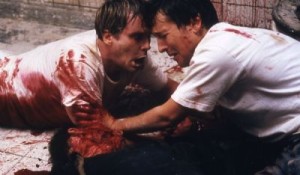
Dr. Lawrence Gordon (Elwes) and Adam Stanheight (Whannell) become brothers in blood on Saw’s dingy bathroom floor.
I can understand why Wan and Whannell would blanch at their hit being called torture porn. Porn usually indicates gratuitous sex (or sometimes action or gore) with no plot. Indeed, Saw has a plot as convoluted and twisted as any of Jigsaw’s traps. It’s clear to me that the two went through a lot of effort to create an involving story. Yet the fact remains that on my first watching I had trouble paying attention to the story for all that was thrown at me. It was a story that would become even more stretched and tangled as sequel after sequel followed, and for its labyrinthine complexity I actually grew to appreciate the franchise more.
Leaving that theater in 2004 I thought Saw wasn’t actually very good, but that’s because I was focusing on the plot (and the various holes it contained). Yet the images of the people in their torment stuck with me for quite some time.
More, as I previously stated, this film’s success created a new horror sub-genre, combining elements of the classic splatter film with the tropes of the slasher horror, yet drawing out the kill scenes in new and inventive ways. From the six Saw sequels to the Hostel films to The Collector to Turistas; each provided a new type of terrible vicarious experience. Truly the most extreme example in this sub-genre must be The Human Centipede — a film that I rejected in concept, but once its torture porn roots came through in the trailer I knew I was in for a treat.
But the genre burned out quickly. By 2009 Saw was clearly over, the sixth installment in the franchise losing a box office battle with the micro-budget found footage film Paranormal Activity. While a few more films, such as Saw: The Final Chapter and Human Centipede II were still to come, the election of President Barack Obama brought with it a shift in media attention away from Guantanamo Bay. That could be coincidence, but it seems more a causation — by the end of the decade humans were tired of facing torture, real or imagined, and preferred supernatural scares on screen. Their votes for political office matched their dollars spent at the box office.
As such, it seems torture porn will remain a symbol of early 21st century American movie-making. Yet out of that sprung some wildly inventive and visceral pictures that may yet inspire a future generation of filmmakers.
Tomorrow — 2005!
Arnie is a movie critic for Now Playing Podcast, a book reviewer for the Books & Nachos podcast, and co-host of the collecting podcasts Star Wars Action News and Marvelicious Toys. You can follow him on Twitter @thearniec
September 3, 2014 Posted by Arnie C | 40-Year-Old Critic, Movies, Now Playing Podcast, Podcasts, Reviews | 2000s, 40-Year-Old Critic, 9/11, Bush, Carey Elwes, Danny Glover, Enertainment, Film, horror, Jigsaw, Movie, Movies, News, Now Playing, Now Playing Podcast, Obama, Podcasts, Review, Reviews, Saw, Shawnee Smith, Terrorist, Tobin Bell, Torture, Torture Porn | Comments Off on The 40 Year-Old-Critic: Saw (2004)
The 40 Year-Old-Critic: Freddy vs. Jason (2003)
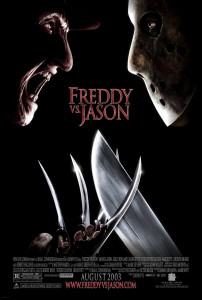 In The 40-Year-Old Critic, Venganza Media creator and host Arnie Carvalho recalls a memorable film for each year of his life. This series appears daily on the Venganza Media Gazette.
In The 40-Year-Old Critic, Venganza Media creator and host Arnie Carvalho recalls a memorable film for each year of his life. This series appears daily on the Venganza Media Gazette.
How many times will I review Freddy vs. Jason? It was one of Now Playing Podcast’s earliest reviews as part of our first retrospective series covering the Friday the 13th franchise leading up to the 2009 remake. Even then we planned to revisit the film and look at it from Freddy’s point of view, which we did the following year during the review series leading up to 2010’s A Nightmare on Elm Street.
By now this should be well-trod ground, and what more could I have to say?
Yet the fact that this is the only movie to be covered twice in Now Playing Podcast retrospectives is indicative of its importance — to film in general and to me personally.
Since our 2010 review I’ve spent a lot more time thinking about the crossover. What is it about two franchises coming together that creates such excitement, especially in the “geek” community? I don’t ask this hypothetically. I personally get swept up in the frenzy when two franchises come together, and it doesn’t even matter necessarily if I like them both! The thought of two universes colliding seems to have a geometric, not additive, increase in interest.
I think to some degree it is fan rivalry at its best. For reasons I don’t understand it seems some fans feel the only way to feel good about their fandom is by putting down others. For example, when Firefly was at its zenith a parade of “Joss Whedon Is My Master Now” shirts filled Star Wars conventions, as if to say, “Star Wars used to be cool.” As such, the “my dad can beat up your dad” mentality started to apply to fan groups; “My stormtrooper can beat up your browncoat.”
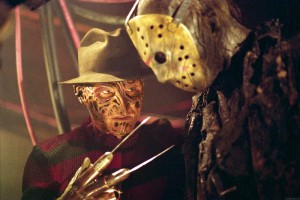
Freddy vs. Jason — whoever loses, the fans win.
That question of who would win in a fight certainly applies to superheroes. In real life, on screen, and online I’ve heard endless debates about which hero is faster, The Flash or Superman. Who would win in a fight, Superman or The Hulk? It is a curiosity, but the chosen winner usually aligns with the speaker’s fan allegiances.
Certainly, speaking of superheroes, comic books have benefited greatly from the crossover. DC Comics had a major hit with its Justice League in 1961, prompting Marvel Comics to respond with its own super team, The Fantastic Four, a move that inadvertently launched the entire Marvel Universe.
Yet, to me, the crossover seemed relegated to just that medium — the comic book. It seemed comics were pulp enough that you could do anything.
Aliens vs. Predator? Sure.
Robocop vs. Terminator? Why not.
Star Trek and X-Men together, you say? Absolutely.
Even rivals Marvel and DC had several crossover series’ that, for instance, led to Superman meeting Spider-Man or Batman fighting the Hulk.
Despite the success and excitement generated by these crossover comics, the concept was rarely conceptualized on film. Universal Studios had done it in the 1940s, when horror icons Dracula, Frankenstein and the Wolf Man came together for the studio’s “Monster Mash” pictures. But Universal owned each property, and when that series ended, crossovers on screen were scarce.
I can recall two that made an impact on me.
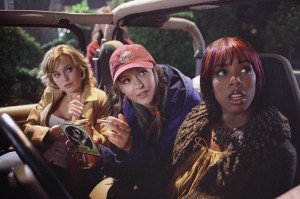
Freddy and Jason aren’t the only names in this cast. Monica Keena (Dawson’s Creek), Katharine Isabelle (Ginger Snaps), and Destiny Child’s Kelly Rowland play teens caught in the middle of the battle royale.
I remember being a young child on vacation with my parents when I saw a trailer for King Kong vs. Godzilla. I had seen numerous Godzilla films, and the 1976 King Kong several times. So the thought of them fighting broke my fragile little mind. I demanded we stay in the hotel room that night so I could watch.
Then, in 1988, Who Framed Roger Rabbit brought together animated characters from Warner Bros., Disney, Turner Entertainment, and more. As I was a teenager, and never really into these characters at my youngest age, the impact was totally lost on me. I saw the film in theaters, thought it was mediocre, and haven’t seen it since.
Beyond those two I can’t think of any groundbreaking crossovers. Some minor ones occurred; such as Star Trek: Generations bringing together cast members from two Trek television series’ (something that had already been done numerous times on Star Trek: The Next Generation, thus lessening the film’s impact). Also, The Monster Squad reassembled the classic Universal Monsters for a kiddie comedy.
But fans wanted more.
So many ideas were teased. Studios knew what we liked, so 1997’s Batman and Robin made sly references to Superman, and 20th Century Fox put an Alien xenomorph skull on a Predator ship in Predator 2. The latter seemed most likely to happen again on film — both franchises were Fox properties in need of a boost. Yet, outside of the Dark Horse comics, nothing materialized for years.
For me, though, more than Aliens and Predators, more than Superman and Batman, Freddy and Jason were the two I wanted to see. Long had the rumor brewed about Hollywood’s (then) top-grossing slashers, Jason Voorhees and Freddy Krueger, going toe-to-toe. I read about it in multiple Fangoria articles in the late 80s and early 90s.
I first saw A Nightmare on Elm Street during a party in 1987, around the time of A Nightmare on Elm Street 3: The Dream Warriors’ release. I found the films so inventive and fun that I rewatched them endlessly, and anxiously awaited each new installment in the series. As detailed during the Now Playing Podcast review, I even cosplayed for the release of Freddy’s Dead: The Final Nightmare. By 2003 I was happy for any new Nightmare, let alone one that pitted villain Freddy against Friday the 13th icon Jason.
I was never as big a fan of the Crystal Lake zombie as I was Freddy, but I did also enjoy the Friday the 13th series. Some of the first R-rated horror I ever saw was Friday the 13th when I came home to find older kids in my house watching it. I tried to join them but the carnage, specifically the decapitation at the end of the 1980 original film, had me fleeing the room. When I finally became a full-fledged horror hound in my early teen years I returned to the franchise when Jason Takes Manhattan was released. While the films lacked the visual panache of the Nightmare series I still enjoyed the films as a guilty pleasure. Over time the series grew in my esteem to be another favorite.

Freddy was killed by fire, but flames don’t slow down Jason.
As such, having both serialized slashers come together would be a dream come true. Or, if done wrong, perhaps a nightmare.
Yet despite the rumors in the horror press and the anticipation by fans such as myself, the killer crossover took 15 years to materialize. Full credit for finally bringing the crossover to screen in the 21st Century must be given to New Line Cinema.
The biggest problem in the 1980s and 1990s was the rights: Jason was owned by Paramount, Freddy was New Line Cinema’s cash cow. The studios tried to work together during the slasher heyday but each wanted to earn 100 percent of the profits by licensing the other’s character. Obviously, that never happened.
Eventually, though, profits started to dry up. Paramount had run Friday the 13th into the ground with crazy concepts like Jason fighting a telekinetic or taking Manhattan. When original Friday creator Sean S. Cunningham wanted to see the franchise continue, specifically with a Freddy crossover, Paramount had no interest. This gave New Line an opportunity. They licensed Jason from Paramount and went to work on Freddy vs. Jason.
While Jason’s creator wanted the crossover, Freddy creator Wes Craven had other ideas. The Springwood Slasher had been given what New Line considered a proper sendoff with 1991’s Freddy’s Dead: The Final Nightmare. But the sequel proved profitable and Craven started planning a return to his iconic franchise. As such, Freddy vs. Jason was put on hold and, instead, Wes Craven’s New Nightmare was made.
Cunningham bided his time, though. In 1993 Jason Goes to Hell: The Final Friday was released and ended with a fan-baiting stinger; Freddy’s glove comes out of the ground and pulls down Jason’s mask. The game was afoot!
We would still have to wait more than a decade for Freddy and Jason to properly share the screen. New Line executives knew the importance of finding the perfect balance between the two famous killers, and so more than a dozen pitches were drafted and subsequently rejected.
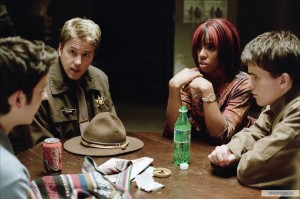
More victims caught in the middle of the killer clash.
Eventually I gave up all hope on Freddy vs. Jason. Nightmare star Robert Englund had not put on the makeup in almost 10 years and I thought Freddy would never grace the screen again. Jason, meanwhile, had gone to space with Jason X (which sat on a shelf for 2 years before its release). Finally, in the early part of the last decade, news — real news — started to come out that the movie was being made.
I honestly believe my excitement for Freddy vs. Jason was on par with my feelings about 1999’s Star Wars Episode I. A countdown clock sat on my computer desktop for 4 months, and when the day finally came I took an afternoon off work to see the first showing.
It met my every expectation.
Directed by Bride of Chucky’s Ronny Yu, the film was outrageous, gory, and over-the-top fun. Both characters got their due (even if Jason inexplicably was suddenly afraid of water) and I couldn’t have asked for more. You can hear a blow-by-blow analysis and both of my reviews at the Now Playing Podcast website, but in short I gave it a strong recommend both times.
Yet loving a movie isn’t enough to garner inclusion in this 40-Year-Old Critic series, there has to be a long-lasting impact. For Freddy vs. Jason, there were two.
First, this film gave Robert Englund a proper Freddy sendoff. It was the best film starring the dream stalker since 1988’s The Dream Master. It cemented a positive feeling for the Nightmare franchise that remains unsullied to this day. Just two weeks ago I had my photo taken with Englund, who was dressed in the full Freddy make-up. I even have ideas for a Nightmare inspired tattoo–the dream killer’s glove slicing into my skin.
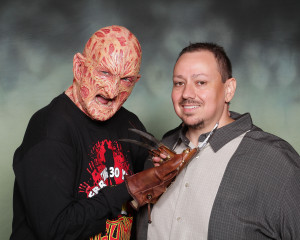
Freddy vs. Arnie — Robert Englund and Arnie pose for a photo at Flashback Weekends in Aug. 2014
Second, though, Freddy vs. Jason’s success launched more than a decade of franchise crossovers. The next year finally saw the release of Alien vs. Predator, which I anticipated every bit as much as Freddy vs. Jason — and which was an utter letdown.
Other pictures released that year include the low-rent, made-for-television crossover Puppet Master vs. Demonic Toys (co-written by Blade and The Dark Knight scribe David Goyer), as well as a return to the “Monster Mash” formula with Universal’s Van Helsing.
Yes, the track record for crossovers wasn’t stellar, but that was honestly my secondary concern — the primary concern was that they were happening. Finally, after decades of teasing, universes were being shared and the world of movies suddenly felt as open as the page of a comic book. But, after 2007’s Aliens vs. Predator: Requiem a shot of adrenaline was needed. I do think the crossover was starting to be seen as desperate, until Marvel Studios took it to the next level.
In 2008 Marvel released its first movie produced in-house: Iron Man. The film stood alone, introducing wide audiences to a superhero that was considered B-list at best. Yet Marvel took a page from New Line Cinema’s book: at the very end Nick Fury showed up to discuss “The Avengers Initiative.” This was the comic book equivalent of Freddy’s hand bursting up from the ground, and Marvel kept its momentum building toward the third-highest-grossing film of all time: The Avengers.
There is a direct lineage from Jason Goes to Hell to Iron Man, from Freddy vs. Jason to The Avengers.
So next spring when you buy your ticket for The Avengers: Age of Ultron (and then download the Now Playing Podcast review) think about the trailblazer that pioneered the modern crossover film: Freddy vs. Jason.
Tomorrow — 2004!
Arnie is a movie critic for Now Playing Podcast, a book reviewer for the Books & Nachos podcast, and co-host of the collecting podcasts Star Wars Action News and Marvelicious Toys. You can follow him on Twitter @thearniec
September 2, 2014 Posted by Arnie C | 40-Year-Old Critic, Comic Books, Conventions, Movies, Now Playing Podcast, Podcasts, Reviews | 1980s, 1990s, 2000s, 40-Year-Old Critic, Avengers, Comic Books, Comics, Crossover, Enertainment, Film, Freddy, Friday the 13th, horror, Iron Man, Jason, Movie, Movies, Nightmare on Elm Street, Now Playing, Now Playing Podcast, Podcasts, Review, Reviews, Ronnie Yu, Sean S. Cunningham, Slasher, Wes Craven | Comments Off on The 40 Year-Old-Critic: Freddy vs. Jason (2003)
The 40 Year-Old-Critic: Attack of the Clones (2002)
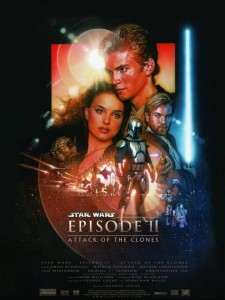 In The 40-Year-Old Critic, Venganza Media creator and host Arnie Carvalho recalls a memorable film for each year of his life. This series appears daily on the Venganza Media Gazette.
In The 40-Year-Old Critic, Venganza Media creator and host Arnie Carvalho recalls a memorable film for each year of his life. This series appears daily on the Venganza Media Gazette.
A week ago, while attending Wizard World Chicago, I had a debate with a Now Playing Podcast listener who claimed Star Wars Episode II: Attack of the Clones was the worst movie in the Star Wars saga. I strongly disagreed.
Not to say I think any of the Star Wars films are bad, per se. I have three tattoos taken from the series. I host Star Wars Action News, a biweekly podcast about Star Wars collecting. I am a devoted Star Wars fan — but I’m also a discerning Star Wars fan that can recognize that those Ewok TV movies are horrible and also distinguish differences in quality among the six films in the saga.
To me, Attack of the Clones was a much needed course correction for the Star Wars prequel trilogy.
To say Episode I: The Phantom Menace left me cold would be a literal truth, as I sat out one night in the freezing rain to get tickets. But it’s also metaphorically true. Perhaps it was how I binged on that first prequel film, seeing it seven times in three days. More, though, I think it was the movie itself. While it boasted the most exciting lightsaber fight in the series, the overall story was somewhat incomprehensible — I had to read various “expanded universe” novels to understand what the Trade Federation was trying to do, and I still think it was stretching. More, the film was completely devoid of humor. The first three Star Wars films had all been fun, with the cocky attitude of Han Solo (Harrison Ford) a centerpiece. Here that sardonic fun was replaced with a walking CGI fish creature stepping in crap.
After The Phantom Menace I slowly found myself drifting away from Star Wars — a major lifestyle change. I had been reading Star Wars novels since 1993, played the video games constantly on my PC, and collected the toys obsessively since 1995. That all peaked with Phantom Menace’s release, when the Toys ‘R’ Us employees informed me that I’d spent the most money of anyone during their midnight toy release, and when I traveled 60 miles every Thursday to get the latest Kentucky Fried Chicken basket topper.
But in the summer of 1999 the glut of Episode I toys clogged shelves. With no new figures found, just the same ones that had been available for months, the thrill of collecting waned and I stopped bothering to look for the next wave of toys. More, I was let down by The Phantom Menace and didn’t wish to dwell on it. I pursued other interests, and stopped buying Star Wars books, toys, and games altogether. It was not a conscious break; when Phantom Menace was re-released in theaters in November of that same year — this time with proceeds going to charity — I saw it again. But that viewing solidified my feeling that my childhood was dead, it was time to move past Star Wars.
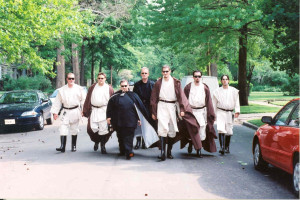
Reservoir Jedi
That stance lasted for a couple years. I even tried to sell my Star Wars collection, only to find that I wasn’t alone. A toy store in Chicago offered me 5 cents for brand new, mint figures — 1 percent of the retail price. He told me no one wanted Star Wars toys, new or old, and that he had a warehouse full of them that he couldn’t sell.
Also during that time my life changed a lot. I met Marjorie, we dated, and eventually moved in together. I also quit my low-paying job and returned to school full-time. We were living off her income and what savings I had put together. Times were tough, bills went unpaid, and there was no extra income to spend on toys. What movies we saw were mostly from the $1 rental bin, not full price theatrical fare.
Despite all this, when the first teaser trailer for Attack of the Clones was released I started to get excited. The trailer was attached to Harry Potter, and so Marjorie and I bought tickets just to see it in the theater. When it played… I was not thrilled. It looked like more of the same that we got in 1999 with Phantom Menace. We were so disappointed we actually left the theater without staying for Potter.
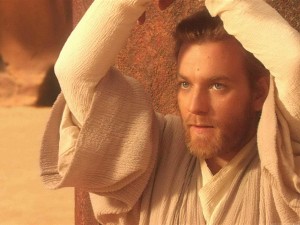
McGregor showed us Star Wars could be fun again.
For me, Star Wars was in a nosedive. But it did pull out, and I remember the moment perfectly. A secret trailer for Attack of the Clones named “Mystery” was released online. A friend came over and he, Marjorie, and I all gathered around my laptop to watch. Another tease, this one focused on an assassin out to get Padme Amidala (Natalie Portman). It showed action, it showed suspense, but best of all it showed humor! It seemed Lucas had realized how dull every character in Phantom Menace had been, and now the sarcastic wit was back courtesy of Obi-Wan Kenobi (Ewan McGregor).
I watched that trailer repeatedly. By the time the third trailer came, my break from Star Wars was over.
But there’s more than that — this film changed my entire life forever.
As mentioned, Marjorie and I were engaged. We knew we were going to get married, but I was hesitating because I was an unemployed graduate student. I had no money, and neither of our parents’ would pay for a wedding. As such, the engagement had no end date, and I hadn’t even scraped the money together for a proper ring. Instead I gave her a placeholder ring that took the last of my cash: $25.
Our excitement for Attack of the Clones grew together; she was as excited for the film as I (and she was nowhere near as hard on Phantom Menace). As such, Marjorie suggested, “What if we have a Star Wars wedding?”
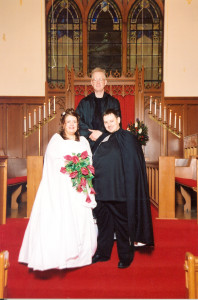
Marjorie, Arnie, and their minister pose for a photo at the wedding.
The thought had occurred to me; I’m not very traditional to begin with, and I considered all weddings to be pomp and circumstance. A tuxedo means nothing to me, nor does a wedding dress to Marjorie. All wedding garb is a costume, so why not make it a Star Wars costume? Plus there was no better time to do it than surrounding the release of a new movie, so a date was set and the Carvalho Star Wars wedding was on.
Her parents were excited. My parents were mortified. We kept certain things traditional — we were married in a church and there were no full-on costumes (I had never heard of the 501st costuming club, if I had I surely would have invited them). As I was the unemployed one I did much of the planning, and I did borrow some money — since repaid — from my godparents to get Marjorie a proper diamond engagement ring; smaller than she deserved but what I could give.
But she had another crazy idea.
The Star Wars Celebration II convention was the weekend before our wedding. As planning had left us stressed, we decided to max out our last credit card and go. I was hesitant; I had gone to a couple conventions in the past but didn’t see the appeal. That said, I had gone only for a couple hours, never an entire weekend. This was a totally new experience, and when we arrived we were immersed in Star Wars. Men in realistic-looking Stormtrooper armor worked security, triggering a latent fear of the men in white. On top of that, celebrities were everywhere; we even had Carrie Fisher (Princess Leia), Billy Dee Williams (Lando Calrissian) and other stars sign our wedding invitation!
Plus, there was new Attack of the Clones footage screened exclusively for convention attendees. We got to see a trailer that parodied Sam Raimi’s Spider-Man, ending with Yoda, lightsaber lit, jumping around like a crazy frog.
I had been excited for Episode II, but now I was practically vibrating with anticipation. I wanted to see Yoda kick ass!
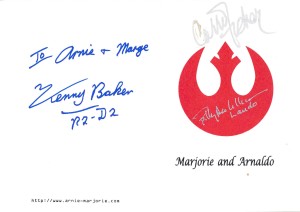
Marjorie and Arnie’s wedding invitation, signed by Star Wars celebrities.
Star Wars Celebration II was a magical weekend bested only by the next one, when Marjorie and I were married. Because of the Star Wars connection local media showed up, and once it hit the AP wire we were known around the country. Our honeymoon in New Orleans felt like a press tour as we woke up every morning at 5 a.m. to talk about our wedding on radio shows, and we were even taken to the local NBC affiliate to appear on MSNBC.
On that honeymoon we went to a midnight screening of Attack of the Clones, which turned out to be one of the worst theatrical experiences in my life. As it was told to me, the theater was showing the film on 16 screens, but had only 4 prints. They were trying to daisy chain the prints from projector to projector, and it didn’t work; the film simply ripped. They had to show the prints to 4 theaters, and the other 12 waited. Finally at 2:30 a.m. the movie started.
I was nervous, what if it was terrible? We were booked to go on MSNBC the next morning, and Marjorie and I had already rehearsed saying, “Loved it!” in unison — lest we look like fools, going on national television about a wedding to tie into a sucky film. The trailers looked good, but after The Phantom Menace I knew there was a risk.
I needn’t have worried. That next morning, when asked by Natalie Morales what we thought of the film, we were honest in expressing excitement. It truly was a return to the Star Wars I’d loved as a child.

The sheer enormity of the clone army excited me.
I’ve seen the movie dozens of times since 2002. Removed from the excitement of the release and the sentiment of our wedding I can clearly see it’s not a perfect film. If ranking the 6 live-action theatrical releases it would be second to last, Phantom Menace at the bottom. I felt the inclusion of Boba Fett as a child was unnecessary to the plot and some of the mysteries never made sense (though at the time I trusted, falsely, that Episode III would answer these questions). Still, the acting was far improved — Portman decided to use her skill this time, and McGregor was a joy throughout. The CGI effects were also better, with the huge battle at the end truly impressing and enthralling me. The lightsaber fight was exciting, and Yoda lived up to my expectations. It has flaws, but was certainly a step in the right direction.
Best of all, it ended with a wedding. Marjorie and I had both gone in spoiler-free and had no idea that we would be married only four days before Anakin Skywalker (Hayden Christensen) and Padme would also tie the knot. To have a Star Wars wedding tying into a new Star Wars film release was one thing, but to be that close to one that also involved a wedding seemed like kismet.

The wedding in Star Wars seemed perfectly timed for our Star Wars wedding.
Though I couldn’t buy Marjorie the ring she deserved, and though the wedding had to be done on a very tight budget, marrying her was the best decision in my life. We have not only shared a life, but we share Star Wars, both through our wedding and now through our podcasts. It would have happened anyway but, to quote Billy Crystal in When Harry Met Sally, “When you realize you want to spend the rest of your life with somebody, you want the rest of your life to start as soon as possible.” Thanks to this movie, it started earlier and has given me more great days than I’d have had otherwise.
More, Attack of the Clones brought me back into the Star Wars fold. I saw it multiple times in theaters, including a trip to Chicago to see it on IMAX — my first IMAX viewing experience. It righted much of what The Phantom Menace wronged.
It brought me back into collecting, as well. New figures were on shelves, but I couldn’t afford them. I finally gave up looking for a dream job and, to pay the bills (and buy a few figures), I took another low-paying temp job. In another unexpected twist, that temp job grew quickly into the career I have today.
And, yes, for our 10th anniversary I finally gave her the ring I wish I could have given her in 2002.
My wife, my work, and my continued love of Star Wars can all be traced back to Attack of the Clones. For that I can forgive its few cinematic flaws and appreciate it for the fun space fantasy that it is.
Tomorrow — 2003!
Arnie is a movie critic for Now Playing Podcast, a book reviewer for the Books & Nachos podcast, and co-host of the collecting podcasts Star Wars Action News and Marvelicious Toys. You can follow him on Twitter @thearniec
September 1, 2014 Posted by Arnie C | 40-Year-Old Critic, Conventions, Now Playing Podcast, Podcasts, Reviews, Star Wars, Star Wars Action News | 2000s, 40-Year-Old Critic, Action, Arnie, Attack of the Clones, Clones, Enertainment, Film, George Lucas, Hasbro, Marjorie, Marriage, Movie, Movies, Natalie Portman, Now Playing, Now Playing Podcast, Podcasts, Prequels, Review, Reviews, sci-fi, Space Fantasy, Space Opera, Star Wars, Star Wars Action News, Toys, Yoda | Comments Off on The 40 Year-Old-Critic: Attack of the Clones (2002)
The 40 Year-Old-Critic: Donnie Darko (2001)
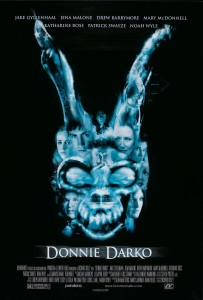 In The 40-Year-Old Critic, Venganza Media creator and host Arnie Carvalho recalls a memorable film for each year of his life. This series appears daily on the Venganza Media Gazette.
In The 40-Year-Old Critic, Venganza Media creator and host Arnie Carvalho recalls a memorable film for each year of his life. This series appears daily on the Venganza Media Gazette.
“You have to watch this movie!” Marjorie exclaimed.
I had just returned home from a very late night at work. I was exhausted and had no idea what she was talking about.
“Donnie Darko. You have to see it,” she told me. “It was on TV tonight. It’s great, but I have no idea what the hell it’s about.”
That, in 2003, was my introduction to Richard Kelly’s directorial debut, Donnie Darko.
I had heard about Donnie, but only in passing. I never knew of its release in 2001; a movie that featured a plane engine crashing into a house was a tough sell just a few weeks after the September 11 attacks on New York City.
The film did catch my eye the following year after it was released on DVD. The title repeatedly popped up at Bloody-Disgusting.com, one of my favorite horror movie websites. Wedged between news articles about Jason X and Bubba Ho-Tep, films for which I had built-in interest, it took several mentions of Darko for me to click the links and read the articles. When I finally did I was confused and slightly put off by the descriptions of a man in a giant bunny suit — I envisioned very low budget, low rent horror from a film with a ghostly bunny.
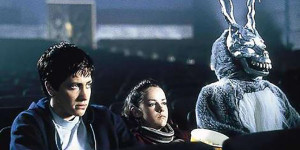
Three’s a crowd when Frank the Bunny comes on your date.
Marjorie’s enthusiasm that night and the online buzz I continued to read convinced me to rent the DVD immediately. I expected straight-up horror, perhaps with a guy in a rabbit suit killing random people.
That was not what I got. Not by a long shot.
First, I wasn’t sure why a website devoted to slasher and horror features spent so much time covering Donnie Darko, which I view as a dramatic sci-fi film. The story invokes concepts of time travel, parallel universes, and psychic phenomena; all delivered in an oblique, theoretical fashion.
When credits rolled I shared my wife’s enthusiastic reaction, but I understood it no better than she did. We talked for hours that night, debating the possible meanings of what we just saw.
What I knew, I knew for a solid fact, was that Donnie Darko was a period-piece teen film. Set in 1988 the story revolves around troubled teen Donnie Darko (Jake Gyllenhaal). On the surface his life looked perfect; he lived in a big house in Virginia, his parents were still together, his older sister was about to enroll in Harvard, and his younger sister was part of the successful dance troupe Sparkle Motion. Yet Donnie is a misfit, full of angst and despair, fighting with all of his family members. He also has weekly therapy sessions where he discusses his sexual fantasies and his fear of being alone.
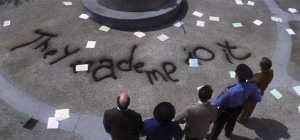
…but who are “they”?
Donnie is smart, his test scores are described as “intimidating”, but at school he has only a small group of friends that discuss nothing more important than the sexual preferences of Smurfs. Early in the film Donnie starts dating the new girl in school, Gretchen Ross (Jena Malone), his first real connection with anyone.
There are some teachers with whom Donnie gets along very well, including science teacher Dr. Monnitoff (Noah Wyle) and English Literature teacher Miss Pomeroy (Drew Barrymore, who also served as executive producer). Both are younger and freer to have open dialogue with their students.
Then there is older health teacher Mrs. Farmer (Beth Grant), an activist who rails against Pomeroy’s teaching of Graham Greene’s short story “The Destructors.” Farmer pushes the school to teach morality based upon the works of motivational speaker Jim Cunningham (Patrick Swayze), who believes everything in life is a choice between love and fear.
Donnie rails against this reductive philosophy, increasing his parents’ view of him as a troubled child.
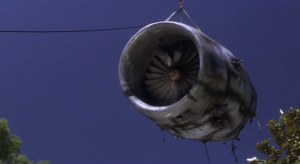
Deus ex machina…a literal God machine.
Taken just as the above, this movie feels like a throwback to classic John Hughes teen fare like The Breakfast Club or Pretty In Pink. It’s the standard tale of a high school student on the precipice of adulthood struggling for free thought in an environment that doesn’t foster such expression. The period-piece setting augments this feeling; the Bush/Dukakis election is referenced, Donnie’s mother reads Stephen King’s It, and the soundtrack features music by Tears for Fears and Duran Duran. There is a large aspect of Donnie Darko that plays just like one of those teen films, and could be taken as such.
But then there’s the jet engine, and Frank the Bunny.
Donnie is a sleepwalker; in the first scene in the film we find him waking up on a hill and riding his bike home. He appears to have been crying.
The next night he is called from his bed by a strange voice. Following it, he finds a man in a strange, dirty rabbit costume, wearing a twisted, frightening, metal bunny mask. This man is Frank, and he tells Donnie that the world will end in 28 days, six hours, 42 minutes, and 12 seconds. We’re not sure if Frank is real or a vision, but it saved Donnie’s life, as that was the night a jet engine crashed into the boy’s bedroom. Had Donnie been there he’d have been killed.
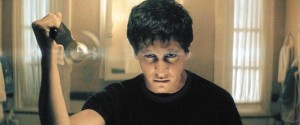
He has a knife in the bathroom. Is Donnie going Psycho?
Every time the film starts to settle into a predictable teen movie routine, something strange happens; Frank appears and gives Donnie destructive orders such as to flood the school or to burn down Cunningham’s house.
Donnie follows the orders, but the audience is left wondering what’s truly happening. Is Donnie a bad kid? Is he having a psychotic break? Is Frank a manifestation of Donnie’s insanity? If the latter is true, then what is with all the talk of time travel and parallel dimensions?
More, each of these bad acts lead to good ends. Flooding the school causes class to be cancelled, and in that free time Donnie first asks out Gretchen. Then, in the ashes of Cunningham’s home, a dungeon full of child pornography is discovered. It’s implied that Swayze’s character may be the head of a kiddie porn distribution ring, and Donnie’s arson helped put an end to it.
Slowly, Donnie becomes convinced that Frank is from the future and that Donnie himself can see future events. He discusses this with Dr. Monnitoff and is given a book, The Philosophy of Time Travel, which precisely details the strange things occurring in Donnie’s life.
Is this the case? Is Donnie insane? Is this all a dream in the character’s head? Is Donnie a stand-in for Jesus?
Simply put, the movie was a mind-fuck. When credits rolled I had no idea what I’d seen, but I knew I enjoyed it.
On Now Playing Podcast I’m often referred to as the critic who places the most importance on story, so it may be unexpected that many of my favorite movies are ones with incomprehensible plots. But I’ve also made it clear on the show that I often love to discuss films more than I love the films themselves. To me, the best movies are conversation starters — films that, as mentioned in True Romance, after watching you can go talk about over a slice of pie.
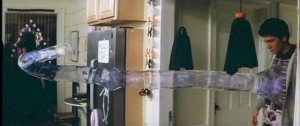
Is this telling Donnie where he will go, or determining his path? If Donnie hadn’t seen this vision would he still have walked this way?
The films need to have a hook; I don’t enjoy every overly dense, incomprehensible, artsy films. There must be some semblance of story, even if the story is not entirely clear. The film also needs relatable characters and circumstances. Having an awesome soundtrack or score, a fun vibe, helps as well.
More often than not this type of film just pisses me off and I never think of it again. But on the rare occasion, when the aforementioned elements come together, the result can be magic. Some other films that embody this include David Lynch’s Lost Highway, Oliver Stone’s Natural Born Killers, and Adrian Lyne’s Jacob’s Ladder. These are movies that stick with me long after the credits roll.
One key to make this type of film come together is the cast. Talented actors, especially familiar faces, can help me feel comfortable when undertaking a strange journey.
I only knew Gyllenhaal as the lead character in the horrible 2001 “comedy” Bubble Boy, and I wrote him off as someone who would never work again. After seeing Donnie Darko, his second lead role, I knew this was an actor with talent and range. This entire film rides on Gyllenhaal’s performance; the character is not only the focus of almost every scene, he’s also going to do illegal and destructive acts. Gyllenhaal gives Donnie a sweetness and vulnerability that makes him sympathetic and genuine. He may be dangerous, to himself or to others, but we want to see him happy.
While I barely knew Gyllenhaal, I was very familiar with his impressive supporting cast. When reading about the film’s low budget, I never expected to see actors I recognized. Yet this cast is full of them. Swayze’s inclusion really helped with the late 80’s vibe, as he was a star at that time with Red Dawn and Dirty Dancing. Mary McDonnell had two Oscar nominations in the 1990s, and soon after Donnie Darko she would rise to prominence again in the rebooted Battlestar Galactica series.
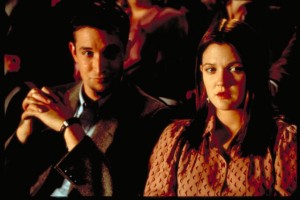
An impressive roster of known stars take bit parts in Donnie Darko.
While those supporting actors were having a lull in their careers at the time Darko was filmed, two stars were at their zenith. Noah Wyle was an actor hot on TV’s ER, and Drew Barrymore was riding high off her career resurgence in Scream.
Credit for this cast, and the film’s own creation, must be given more to Barrymore than Kelly. After Scream, Barrymore had begun a successful producing career with back-to-back hits Never Been Kissed and Charlie’s Angels. Kelly had no luck getting his film produced until Barrymore took on the project, and her involvement helped raise the $4.5 million budget and draw named talent to the project.
All of these elements combined to create an enjoyable movie viewing experience. But what was it about? I felt like I almost got it on my first viewing. Hours of reflection with Marjorie made us each realize a point, a line, which the other had missed.
We watched the film again the very next day, and I got a little more. My impression upon second viewing was that Donnie, a depressed and lonely boy, got to experience one month of happiness and reconnect with his family before he was destined to travel through time and die. I believe it was his destiny to die, but, thanks to unexpected time travel, his death is less tragic than it might have been.
I then spent the entire following day on the computer visiting the Donnie Darko website (no longer online but partially available via archive). Following the example set two years earlier by The Blair Witch Project; the Donnie Darko site was completely in-universe. I could read police reports about Donnie’s 1986 arrest for arson (briefly mentioned in the film), or the newspaper article about pedophile Cunningham’s suicide in the days after the film ends.
The site itself was as dense as the picture, with no obvious navigation. Animations played out on the screen and strange phrases appeared. As a gamer and web designer, the site sucked me in as much as the movie. It was designed perfectly from a psychological standpoint — I would click enough obscure links to get just a drip of information. Like a rat awaiting a treat I repeatedly pushed buttons. I sat at that computer all day, and I remember it well. I didn’t eat, I didn’t move, I just looked for more and more meaning.
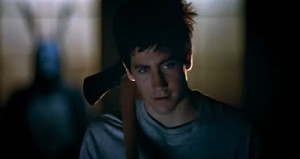
Donnie getting ready for school…
The site was filled with excerpts from the fictional book The Philosophy of Time Travel, written years ago by an old lady Donnie and his friends call “Grandma Death” (Patience Cleveland). The text talked about tangent universes, living receivers, the manipulated living, the manipulated dead, ensurance traps, and more dense terms. No, the site wasn’t here to give me clear answers, but it did aid in my interpretation.
Obsessed, I watched the movie again and this time I thought I had it. I could map the information in the site to the characters on screen. I had an explanation. I didn’t waver from my thought about Donnie experiencing happiness in his final days, but I did start to understand a little more about the mechanics of time travel in this movie, and how Frank the Bunny came to be.
Some may be right to say that films shouldn’t require hours of research to understand. To that I say it wasn’t required, it was desired. The film hooked me enough that I wanted to know more; I had my theories but for me it’s often more interesting to know the director’s vision and intent. Sometimes the intent is ambiguity, but other times they have many ideas but one “truth.”
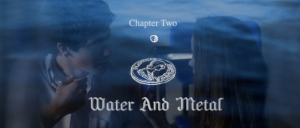
This is not a DVD menu or bonus feature. In the Donnie Darko director’s cut text is put on the screen to try and explain the film to the audience.
Finally, in 2004 I had the chance I missed in 2001 — to see Donnie Darko in theaters. Marjorie and I both drove to Chicago to see the limited release, joined by my Now Playing co-host Stuart, who had not yet seen the film.
The movie had been heavily edited between its Sundance premiere and its wide release. The director’s cut restored 20 minutes of footage, but made even more changes. In what I’m guessing was an attempt to be more accessible for mainstream audiences, Kelly added text to the screen — text taken straight from the Donnie Darko website.
There were other changes, including dialogue and music, but I felt adding the text was going a bit too far. In an effort to be less dense the director had created a weird movie experience that was akin to looking at an appendix while watching. I was happy with some of the scenes put back in the film, ecstatic to see it on the big screen, but in the end I prefer the original cut without the text. I liked the mental challenge of trying to piece this movie together on my own (Similarly, Lost Highway lost some of its appeal when the director went on record stating that film’s “truth”).
Having said that, I’m not certain that even with the text Donnie Darko is so clear-cut. For this review I re-watched the film for the first time in several years. I am a different person in 2014 than I was in 2012; as this review series indicates, I’m becoming more reflective about issues of life and mortality. In this viewing I saw a totally new interpretation of Donnie Darko, one that does involve time travel but also fate, destiny, and the will of God. When I took this as solely a sci-fi drama I missed the spiritual themes that permeate the movie.
In my original thesis, I believed that Donnie needed to connect and feel happiness before his death. But now I see the subtext about “God’s channel” — that Donnie had free will, he didn’t have to die, but to do so was to deny God. Donnie was having an existential crisis; his loneliness came in part because he didn’t want to die and he found no way to believe in anything more than this world. Through the experiences of this movie Donnie not only realizes his role is to die, but he knows it’s his choice to die. He could deny his fate, but in doing so he would deny God’s will. If God has will then there must be a God, and so, reassured and finally finding proof in divinity, Donnie laughs as he takes that next step into the afterlife.
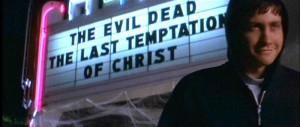
The viewer gets to pick which movie they see through various interpretations of Donnie Darko.
Yet, the more I ruminate on this movie, I would not say my interpretation is the only one. While I think it is what Kelly was going for, so many other interpretations are possible. I would be hard pressed to argue against a reading that Donnie is schizophrenic and having a psychotic episode, as his psychiatrist suggests. I read a theory online that Frank is like The Ghost of Christmas Future and no time travel actually happens, Frank just shows Donnie a vision of what could be. You could say this film is just a take on the theme of the Final Destination films — Donnie was supposed to die and, since he didn’t, Death surrounds him.
The alternate theory, though, that I think Kelly teases most is that there is no such thing as time travel, and this entire move is Donnie’s dream in the moments before his death, in the spirit of An Occurrence at Owl Creek Bridge. This is very clearly given as an option when Donnie and Gretchen go to a two-screen movie house. Do they choose The Evil Dead or The Last Temptation of Christ (which depicts such a dream-in-the-moment-before-death scenario)?
The film’s very final scenes, though, seem to indicate that others in town have a lingering memory, like an almost-forgotten dream in the night, of what Donnie experienced. That realization, that something happened to people other than Donnie, always returns me to my original theory: Donnie had to die, but he got to die after experiencing joy.
Even with this seemingly uplifting message, the movie is horribly sad. I well up every time during the film’s denouement. It’s set to a slow, somber cover of Tears for Fears’ “Mad World” sung by Gary Jules. I had never given that song’s bubble-gum pop lyrics much thought, but this version, mournful and soft, gave the words meaning I’d never considered. It’s the rare cover that makes all earlier versions of the song obsolete (though never, ever listen to the second version on the soundtrack where they added drums and other instrumentation. It is virtually ruinous to the perfect, minimalist recording).
A sequel to this film was released, S. Darko, telling an equally strange and surreal story about Donnie’s younger sister Samantha (Daveigh Chase). That film may contain more answers, but I refuse to see it. It was a studio made product with original creator Kelly having absolutely no involvement, insight, or approval. The director even took to social media to clarify that this was done without him. As such, I will never, ever watch this sequel, for my fear is that S. Darko won’t merely be terrible but, like the previously mentioned remix of “Mad World,” it will permeate my thoughts when I return to the original and ruin my enjoyment.
Donnie Darko changes every time I see it, or perhaps I change every time it sees me. It’s a film that has long moments of Donnie looking into a mirror, and perhaps that’s what I’m doing. In a film this impenetrable it’s easy to project your own thoughts and desires. What I do know is this is an absolute masterpiece of a film that everyone should watch.
When you do, share with me your theories. I’d love to hear them.
Tomorrow — 2002!
Arnie is a movie critic for Now Playing Podcast, a book reviewer for the Books & Nachos podcast, and co-host of the collecting podcasts Star Wars Action News and Marvelicious Toys. You can follow him on Twitter @thearniec
August 31, 2014 Posted by Arnie C | 40-Year-Old Critic, Movies, Now Playing Podcast, Podcasts, Reviews | 1980s, 2000s, 40-Year-Old Critic, Donnie Darko, Enertainment, Film, Mad World, Movie, Movies, Now Playing, Now Playing Podcast, Podcasts, Review, Reviews | 2 Comments
The 40 Year-Old-Critic: Requiem for a Dream (2000)
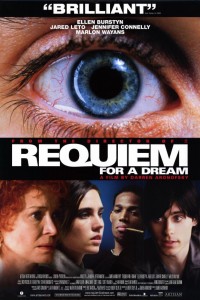 In The 40-Year-Old Critic, Venganza Media creator and host Arnie Carvalho recalls a memorable film for each year of his life. This series appears daily on the Venganza Media Gazette.
In The 40-Year-Old Critic, Venganza Media creator and host Arnie Carvalho recalls a memorable film for each year of his life. This series appears daily on the Venganza Media Gazette.
Have you ever seen a film that you instantly loved, but never wanted to see again? That was my reaction to seeing Requiem for a Dream in 2000.
I was drawn in by director Darren Aronofsky. I had seen his first film, the black-and-white techno thriller Pi, and was enthralled. The use of music, the sophisticated themes, the weird camera angles, the ideas of patterns in everything in life, the repeated sequences that formed a pattern in a movie itself about patterns; all of it left me entranced. I instantly knew Aronofsky was a talent to watch.
I anxiously awaited Requiem’s release, my excitement growing as I read high praise coming out of its screening at the Cannes Film Festival. Being a small film ($4.5M budget) with a very non-commercial NC-17 rating, I knew Requiem would not get a wide release. Sure enough, the picture opened on just 93 screens.
Like a character in an Aronofsky film, I was obsessed with seeing this movie. As such I made plans to visit my Now Playing Podcast co-host Stuart in Chicago, and there we would go see Requiem together.
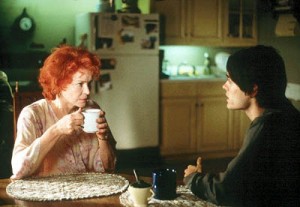
Burstyn and Leto share a rare scene together in Requiem for a Dream.
Based on the novel of the same name by Hubert Selby, Jr., the film follows nine months in the lives of Harry Goldfarb (Jared Leto) and his mother Sara (Ellen Burstyn). Despite the familial relation, the two characters rarely interact; their stories run parallel as we follow their hopes and falls. Starting in “Summer” and ending in “Winter”, the falling temperatures also represent the decline in the characters’ fortunes.
Harry is a heroin addict. He and his friend Tyrone (Marlon Wayans) have hit bottom so many times that stealing Sara’s television to pawn for drug money has become routine. After one theft, followed by a good high at the beginning of the film, Tyrone starts to show ambition –rather than just shooting up, the friends decide to resell some of their drugs to double their money. They have career aspirations of someday dealing a full pound of pure heroin that would set them up for a long time and allow Tyrone to move out of his bad neighborhood.
They start their plan — taking regular pauses to shoot up — and things start to go well. Harry even earns enough money to try to make amends with his mother, and buys her a new, modern television.
In addition to Harry’s burgeoning career as a drug dealer, he is madly in love with girlfriend and fellow junkie, Marion (Jennifer Connelly). The two dream of using their drug money to open a clothing store, allowing Marion to escape her controlling parents. With his money and his girl, things look great for Harry.
Sara, meanwhile, is also finding success. When the film begins she is an elderly widow living alone in an apartment, with little to do but watch self-help television shows. One day her fortune changes with a single phone call: she has been selected to be on her favorite game show. Sara is beyond excited, but also nervous about appearing on national television. A neighbor helps her dye her hair, with unfortunate results. She’s even more distressed after finding out the red dress she wants to wear on the show — one her late husband loved — no longer fits.

Sara starts popping the pills faster and faster to fit in that red dress.
After attempts at crash dieting prove unsuccessful, Sara visits a doctor and begins taking a heavy dose of diet pills. The amphetamines have severe side effects — Sara starts to grind her teeth and can’t sit still — but she loses 25 pounds and feels great. Her looming television appearance has made her the superstar among the retirees in her apartment building and she’s soaking it up.
When Harry brings his mother the new television he instantly knows Sara is tweaking on uppers. He tries to get her to stop, but she is too excited for the game show; even though her obsessive checking the mail for information about her appearance has yielded no results.
If you haven’t seen Requiem for a Dream, if you’ve only read the description above, you might think this is an ugly movie about despicable people. A heroin addict who steals from his own mother? A lonely old woman obsessed with television? A junkie aspiring to become a dealer? In so many movies these characters would be the villains, or at least the antagonists. But Aronofsky is a deft storyteller, and slowly he makes us care for each person on the screen.
Every character is given a touching moment. For Harry and Marion, it’s them lying in bed expressing their affection for each other. They don’t just say “I love you” — rather Harry uses the trite expression, “You’re the most beautiful girl I’ve ever seen.” She responds, telling him she’s heard that a lot, but adds that when Harry tells her it truly has meaning.
More than words, we see that scene through the points of view of both characters via split-screen, allowing for close-ups of Leto and Connelly. This unique approach drives home multiple points: a) they’re together, yet not, b) it’s the first sign that something will come between them, and c) the close-up shots convey intimacy, not isolation.
Then the shots get more inventive. We see Harry talk on one side of the screen, and on the other we see his hand caressing Marion, his thumb brushing over her lips, her palm. Then we see her close-up, and her hands on him. It’s not a sex scene, but this communion between two characters shows their relationship in a much more intimate setting. After only two minutes you want these kids to make it, yet their addiction hangs like a storm cloud.
The same goes for Harry and his mother. While he starts by stealing her television, causing Sara to lock herself in a closet away from her son, he still tries to assure her that everything will be okay. Later in “Summer” we see Harry and Marion on the beach, the man verbalizing how much he loves and cares for his mother and how, now that he has money, he wants to make right every wrong he’s done. It’s a deft turn, but thanks to Leto’s performance and earnest language, Aronofsky has made this thieving drug abuser actually seem noble and good.
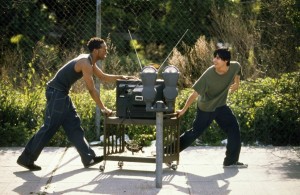
Harry and Tyrone take in some TV.
Tyrone is given the least background of the four, an odd choice considering he is the lead drug dealer. His girlfriend is never named, and his backstory is limited to a bit about honoring his dead mother. Still, Wayans gives a career-best performance in a rare, non-comedic role for the Scary Movie actor. Much of this is due to Aronofsky’s editing — one needs only to watch the deleted scenes on the DVD to realize Wayans tried multiple approaches to Tyrone, including a full-on Jar Jar Binks impersonation.
As shown on screen, Tyrone is the least developed character, yet still a likable personality thanks to the heart Wayans puts into the role.
It’s actually astounding that Requiem makes drug dealing seem like a bright, hopeful career path.
As for Sara, this character may not be one you hate, but one you pity. A virtual shut-in with a television obsession, it is again the script and the actress that makes Sara sympathetic instead of just pathetic. When Harry comes to tell his mother about the new television he asks why she cares so much about the game show appearance.
She responds at first by pointing out to Harry the reverential treatment she has been getting from the other biddies in her building:
“I’m somebody now, Harry. Everybody likes me. Soon, millions of people will see me and they’ll all like me. I’ll tell them about you, and your father, how good he was to us. Remember?”
Then after a pause, an even sadder truth comes out — this television show is all she has to live for.
“It’s a reason to get up in the morning. It’s a reason to lose weight, to fit in the red dress. It’s a reason to smile. It makes tomorrow all right. What have I got, Harry? Why should I even make the bed or wash the dishes? I do them, but why should I? I’m alone. Your father’s gone. You’re gone. I’ve got no one to care for. What have I got, Harry? I’m lonely. I’m old.”
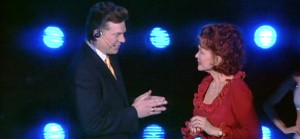
Sara hallucinates a visit to her favorite TV show, hosted by Tappy Tibbons (Christopher McDonald in a memorable minor role).
The obvious answer is right there: Harry could pay more attention to his mother. What she really needs isn’t another television, it’s human connection. But while Harry is desperately trying to be a good son he’s exacerbating his mother’s issue by allowing her to submerge deeper into television, versus helping her to escape it. Despite seeing his mother’s obvious bad reaction to the uppers, this is the last time Harry sees her.
Even with the obvious, unspoken truth of the scene, the monologue could have fallen flat if not for Burstyn’s amazing performance. She jitters while she plays the scene, expressing her agitation from the pills, with a nervousness at being so honest with anyone. She says the lines with a smile, but the sadness comes through in the delivery. Burstyn deserves every accolade she was given for this performance.
Finally, the mood is lightened with humor. When Harry and Tyrone steal the television it’s a joy watching them wheel it past all of Sara’s neighbors, who are more concerned with soaking up the afternoon sun than they are the obvious and strange theft. The characters laugh, joke, and keep the film from becoming too morose.
The combination of the amazing director, actors, and screenplay prevent this story from feeling trite or ugly. When “Summer” ends I was rooting for all four characters to achieve their dreams.
But if that was the summer, soon must come the fall, literally and metaphorically.
For Sara, this comes from her body building up a resistance to the amphetamines. She no longer gets her high from the pills, and though her red dress nearly fits, she needs to continue losing weight. When the doctor won’t up the dosage she self-medicates, taking multiple pills at once.
For Harry, Marion, and Tyrone, their downfall begins when a drug war breaks out in the city. Supplies of heroin have dried up — they can’t get any more to sell, and they can’t get any more to take. Their relationships are stressed, especially by Marion, who seems to suffer the worst withdrawal and blames Harry for her inability to shoot up.
By the time the film gets to “Winter” the movie is no longer a dark comedy. Each character becomes more desperate, and their ends are each so awful that Requiem for a Dream practically becomes a horror film. Yet none of it would work had we not cared for the characters — we would have applauded horrible people getting their just desserts. That I love these people and don’t want to see their ruination is the result of successful, manipulative storytelling of the best possible sort. Aronofsky made me like them, then pulled the rug out from under them — he did the same to us in the audience.

When I left the theater I was shaken and sad. The ending was depressing, but it was just; and I realized that. I felt as mournful as I would for a friend who’d gone down a bad road. This movie was hard — hard to watch, hard on its characters, and hard on the audience. I left the theater knowing I loved every frame of this film but also thinking it was such an emotional trial that I never wanted to watch it again.
I did though, many times. Beyond just great storytelling, Requiem for a Dream is a visual masterpiece that I — after some time passed — wanted to revisit to fully take in.
Aronofsky’s second feature brought back so many of the things I’d enjoyed in Pi, especially the inventive, experimental camerawork. Now, more than a decade later in a time when GoPro cameras are strapped to everyone’s heads, you see the genius in Aronofsky’s self-proclamed “Schnoz cam” — strapping the camera to an actor so the person always stays in the center of the frame while the background and scenery move around them. First used in Pi and then in Requiem, this gave the feeling of a character surrounded by a world out of control — a sign of madness, or a visual representation of vertigo. When sped up film footage is added to the effect, you see that Aronofsky created an entirely new way to deliver the same emotion as the old Hitchcockian “push and pull” change of depth.

Sara finally fit in her red dress, but at what cost?
One of the things that impressed me about Pi was its unique visual style. Despite being very low budget, the use of superimposed images, quick cutting, and repetition was hypnotic. That is also on full display in Requiem. Every time the characters get high, be it by snorting, shooting up, or popping pills, a ritual is performed. The film cuts to a montage that lasts only seconds but shows the actions, and the characters. A lighter is lit, drugs boil, a syringe fills, blood courses through veins, pupils dilate. It all happens so fast that it’s virtually subliminal, yet it tells us everything we need to know. As the film becomes more desperate the montages are even faster, showing us people stuck in a cycle of self-destruction.
Aronofsky also isn’t afraid to get surreal. In the depths of psychosis Sara sees cupcakes floating in the air, her favorite self-help TV personality appears in her living room, interlaced at her television’s 480 lines of resolution. At one point her refrigerator even opens a gaping maw to eat her. These types of shots could undermine the mood but, as done here, they just enhance it.
In addition to the camerawork, enough credit simply cannot be given to composer Clint Mansell. I had the CD from Pi, his first film score, on an endless loop in my car; the electronic techno score was perfect for that film about a computer programmer, but I never would have thought the composer could hit the emotional resonance he did when he reteamed with Aronofsky for Requiem.
As this was a low-budget film, the score was performed by just four people: The Kronos Quartet. Still, with just violins, a viola, and a cello this score permeates nearly every frame of the movie. The low, sonorous tones of the cello dominate and make even the happy scenes foreboding. It’s a gorgeous composition that feels so classical it’s impossible to believe it was written in the 21st century; it feels like the work of Edvard Grieg, or one of Beethoven’s darker works.
The score has such an emotional resonance that it has been the breakout star of Requiem for a Dream; even if you’ve not seen this film I guarantee you’ve heard the score’s climactic movement, “Lux Aeterna.” Just two years later, in 2002, my jaw hit the floor when the trailer for Peter Jackson’s The Lord of the Rings: The Two Towers was scored to an orchestral version of “Lux Aeterna” — the assemblage of instruments and a faster tempo giving the song a more epic feel than the Quartet did alone (This orchestral version is available for digital purchase at Amazon).
In the years since, “Lux Aeterna” has been a go-to track for movie trailers, including Zathura, I Am Legend, Sunshine, The Da Vinci Code and, unlikely as it may seem, it was even used in Barbie doll ads!
Combined, every element of this film comes together as smoothly as one of Harry’s heroin montages. More, the performances, cinematography, and soundtrack all underscore the film’s thesis — summed up in the title — about the lengths to which people go to try and achieve their dreams. No matter what your dream, be it to be a TV star, a clothing shop owner, a screenwriter, or a podcaster, it’s a plight to which everyone can relate.
Aronofsky finally achieved mainstream success and acclaim with 2008’s The Wrestler, and then went on to even greater success with 2010’s Black Swan. I consider that unfortunate. While I like both of those films, the director has never achieved a more perfect theatrical representation of obsession than he did with Requiem for a Dream. And though I’ve yet to see this year’s Noah, my feeling is Requiem is Aronofsky’s best film to date.
Even if I do have to steel myself every time I rewatch it.
Tomorrow — 2001!
Arnie is a movie critic for Now Playing Podcast, a book reviewer for the Books & Nachos podcast, and co-host of the collecting podcasts Star Wars Action News and Marvelicious Toys. You can follow him on Twitter @thearniec
August 30, 2014 Posted by Arnie C | 40-Year-Old Critic, Movies, Music, Now Playing Podcast, Podcasts, Reviews | 2000s, 40-Year-Old Critic, addiction, Barbie, Darren Aronofsky, dealing, Drama, drugs, Ellen Burstyn, Enertainment, Film, Heroin, horror, Jared Leto, Jennifer Connelly, Lord of the Rings, Lux Aeterna, Marlon Wayans, Movie, Movies, NC-17, Now Playing, Now Playing Podcast, Podcasts, Requiem for a Dream, Review, Reviews, The Two Towers | 2 Comments
The 40 Year-Old-Critic: The Blair Witch Project (1999)
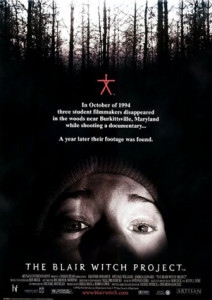 In The 40-Year-Old Critic, Venganza Media creator and host Arnie Carvalho recalls a memorable film for each year of his life. This series appears daily on the Venganza Media Gazette.
In The 40-Year-Old Critic, Venganza Media creator and host Arnie Carvalho recalls a memorable film for each year of his life. This series appears daily on the Venganza Media Gazette.
As I did with my 1980 review of Popeye, I do feel the need to address the elephant in the room: how can my pick for 1999 be anything other than Star Wars Episode I: The Phantom Menace?
It seems the likely choice. After 16 years a new, original Star Wars film was about to hit theaters, Lucas was directing for the first time in 22 years, and it was the top-grossing film of ’99.
Those who know me know how hyped I was for that film. I spent hundreds of dollars on toys and sat outside overnight in excessive rain, and later tremendous heat — third in line to get my ticket.
The Phantom Menace came and went, and when the year ended I realized the film had left me strangely unfulfilled. It defied expectations by actually making a Star Wars film boring. I have neither glowing nor damning things to say about Lucas’ return to directing. I’ll say this: It is certainly not a film that has impacted my life.
Instead, the film that stuck with me most from 1999 is not a big-budget Hollywood production, it is the smallest of films which became the year’s most profitable: The Blair Witch Project. I had never seen a movie like it before, and I’ll likely never experience one that way again.
The Blair Witch Project was more than a movie in 1999, it was a movement, and one that began months before it hit theaters.
I discovered The Blair Witch Project early in the year after reading about the film’s website, which was unlike any site I’d visited before. Odd and confusing, it told of Blair, MD, a town surrounded by superstition and mystery. I recall a timeline of events and some very low-res video. I also recall spending hours on this site, mostly waiting for the videos (which in today’s world would be tiny) to download to my 56kbps dial-up modem. The clips included news reports that seemed real enough, and introduced a mystery of three missing young people and rumors of the supernatural.
What the site didn’t mention was that it was all fictitious.
Have you ever wondered what it would be like to live in 1938, when an unsophisticated radio audience went into a panic over Orson Welles’ War of the Worlds? Or to be in 1974 and think there really was a chainsaw-wielding cannibal in Texas, instead of a story inspired by Ed Gein? The closest I will ever come to that is The Blair Witch Project. I found the site knowing of the film, but thousands didn’t — including some of my friends whose intellect I respected. They should have known better, but the age of the Internet hoax was not yet upon us.
This type of viral marketing is common now and thousands of movies have tried to replicate what Blair Witch innovated; but years before “viral video” was in our lexicon the Blair Witch website spread like wildfire via e-mails sent from person to person.
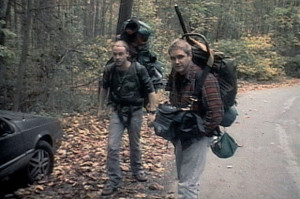
Josh and Mike begin their investigation.
From the presentation on the website, to the documentary-style filmmaking, it was very easy to be sucked into the “reality” of The Blair Witch Project. I watched as friend after friend fell for the ruse. Even as trailers for the film ran in theaters and on television, audiences weren’t sure if this was real.
“Don’t tell anyone,” I remember one friend confiding, “but I don’t think The Blair Witch Project is true.” I laughed and said, “Probably not, as I saw the lead actress on Jay Leno last night.”
Yes, even with a huge publicity push that involved multiple television appearances by the cast, audiences didn’t know what to make of The Blair Witch Project. That thousands of people could be so swept up in a shared fantasy, let alone one made by a few indie filmmakers and not Hollywood’s marketing machine, is phenomenal in the most literal sense of the word.
I went to see Blair Witch the weekend it opened. It had received so much acclaim in the media that I was excited to see the next evolution of horror. Plus I was curious; the website’s videos had asked many questions and I wanted to know the answers.
Initially I was put off by the filming technique. The early scenes introduce the three documentarians — Heather Donahue, Mike Williams, and Josh Leonard (all actors, but using their given names for the film) — as they set out to make a film about the myth of the Blair Witch. The early scenes have some comedic value and a bit of an eerie feel, but overall I wondered if I’d made a mistake. The shots seemed so amateurish and shaky. I knew this was low-budget filmmaking, but even in movies like Clerks and El Mariachi I’d never seen camera work like this — it felt like something I would shoot with my parents’ video camera and no tripod.
More, the characters seemed petty and dull. I knew they were actors, but they didn’t seem like very good ones. The bickering about a map, the various spats, I wondered when the horror would start.
But slowly the film sucked me in. Perhaps it was the first-person views, or maybe it was something instinctive — Heather’s constant cries for help breaking me down and stirring something primal inside me that is agitated by a female shriek. No matter, halfway through the movie, when Josh disappears, I was really invested in these characters and their plight. When Heather finds a small tied bundle and unwraps it I strained my eyes to see what was inside. There was blood and… were those teeth? Hair? It wasn’t gore like I was used to seeing; it was even more unnerving.
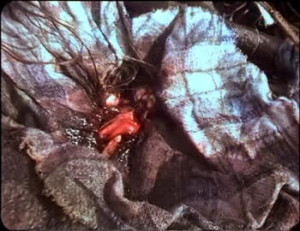
What… is… that?
By the time Heather, snot dripping from her nose, delivers her famous monologue to the camera I was totally taken. The Blair Witch Project did something no film had done since I was a child: it made me afraid. The tension of the scenes and the way it all felt so real; I had an uneasy feeling that I couldn’t just write off. The movie had gotten to me.
When the climax comes with Mike and Heather running through a house, then seeing Mike’s camera fall, I was dying to see more, to know more. Then, when Heather screams and her camera hits the ground and we see — is that Mike? Standing in the corner? I was enthralled, and frustrated. The film had provided no clear answers; what we saw could have been taken many different ways. But I had undergone the most exhilarating movie experience of 1999.
Among my audience I seemed to be the only one with that feeling. As credits rolled I witnessed something else I’d not seen before or since: a man around 50 stood up and shouted, “They must be pretty hard up for movies to put crap like that on the screen.” He left, disgusted.
That did not dampen my excitement. This was a movie unlike any I’d ever seen before, one that intentionally blurred the lines between fiction and reality (actors using their real names, regular citizens interviewed about a fictitious witch, etc.). More, the first-person filming technique had made me feel a part of the film.
According to Wiki, The Blair Witch Project was not the first “found footage” movie, but it was close, and it was the first that I had seen. Going in I had thought it unlikely I could find it believable that, in the midst of utter terror, these characters chose to keep the cameras rolling. Keep in mind this was before cell-phone cameras, YouTube, and the learned instinct of pulling out a camera every time tragedy occurs. Yet the way Heather, Josh, and Mike acted; their need for the security found through the camera lens, made me a believer.
That said, I thought it was a one-trick pony. Surely no film could pull this off again. How wrong I was. Blair Witch inspired a generation of filmmakers to try and replicate this formula. There were only seven “found footage” films released before Blair Witch; there have been more than 100 in the years since. Think about that.
Directors Daniel Myrick and Eduardo Sanchez were not trying to invent a new film style, they simply didn’t have the money for a full crew and improvised with actors, untrained in camerawork, filming each other. Yet now it seems impossible to escape this overused horror trope. I have seen so many “found footage” films, from Cloverfield to Chronicle to V/H/S to Diary of the Dead, and none have done it as well, or as believably, as Myrick and Sanchez did in 1999.
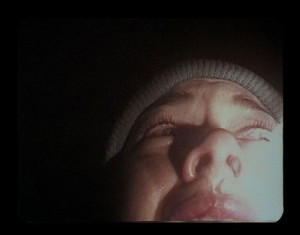
The scene you’ll never forget, and neither will Heather Donahue.
Initially I was drawn to Hollywood’s “found footage” trend, hoping to recapture that Blair Witch feeling. Now I avoid them at all costs, realizing the first was the best. In the end I like my movies to be cinematic. Blair Witch was a novelty but the constant output of more “found footage” movies has become a massive turnoff for me.
With Blair Witch as my first “found footage” experience I was shocked that my second wasn’t Book of Shadows: Blair Witch 2.
Released the following year, I remember taking Marjorie to see it opening weekend. While nowhere near as inventive, original, or tense as the first film, there were aspects of that sequel I enjoyed. The post-modern idea of “The first film was a movie in this second film!” was novel, and the hard rock soundtrack was fun.
My love of Blair Witch continued, though the property continued to be watered down. I bought all three videogames, and even the Blair Witch action figure. Yes, McFarlane Toys made two figures of a character never seen on-screen.
I have since escaped the Witch’s spell. I sold the figures, and the games were a dull mess. I haven’t seen the sequel since its DVD release in 2001. Yet the Blair Witch Project is a film I still hold in high regard.
Tomorrow — 2000!
Arnie is a movie critic for Now Playing Podcast, a book reviewer for the Books & Nachos podcast, and co-host of the collecting podcasts Star Wars Action News and Marvelicious Toys. You can follow him on Twitter @thearniec
August 29, 2014 Posted by Arnie C | 40-Year-Old Critic, Movies, Now Playing Podcast, Podcasts, Reviews | 2000s, 40-Year-Old Critic, Blair Witch Project, Enertainment, Film, Found Footage, horror, Indie Film, Movie, Movies, Now Playing Podcast, Podcasts, Toys | Comments Off on The 40 Year-Old-Critic: The Blair Witch Project (1999)
Review: The Chronicles of Riddick: Dark Fury
At the end of Pitch Black only three passengers of the spaceship Hunter-Gratzner were still alive. These three, Riddick, Jack, and Imam, took to space, destination unknown. Possibly New Mecca, if their little shuttle could make the trip. At the beginning of Pitch Black’s follow-up film, The Cronicles of Riddick, Riddick is a shaggy haired, scruffy bearded refugee on U.V. 6 chased by a bounty hunter named Tooms, Imam is on a planet called Hellion Prime, and Jack is a captive on the prison world of Crematoria.
Did you wonder how these three survivors split up? Why they were not all living happily together on New Mecca? Nope, those questions never crossed my mind either, but continuing to answer questions fans never asked come DVD bonus features and animated interquel films, such as The Chronicles of Riddick: Dark Fury.
This direct-to-video animated short picks up immediately where Pitch Black left off. We see Riddick’s shuttle had barely left the planet when a mercenary ship arrived and captured the three survivors of the Hunter-Gratzner. But this is no ordinary merc troupe—this cadre is led by Antonia Chillingsworth, a psychopath who equates murder with art. She has traveled the galaxy collecting the most notorious killers and turning them into frozen, living statues in her gallery, cherishing the artistry of homicide.
What are the odds of such a collector randomly stumbling across Riddick, one of the galaxies most infamous killers? Slim. But logic goes out the window early in this action-fest who’s real purpose is not to tell a story but to entice Pitch Black fans with more of Vin Diesel’s monotone lines, and more of Riddick’s talent for killing.
The short was directed by Peter Chung, and without knowing his name I knew his work—the animation style, violence, and sensibility of Dark Fury closely mirrors that of Chung’s best-known creation Aeon Flux. Despite being based on a story by Riddick’s creator David Twohy, the film has Chung’s fingerprint on every frame. As such, your opinion of Chung’s old Liquid Television action heroine will likely influence your viewing experience of this Riddick animated movie.
With Chung’s style-over-substance approach Dark Fury’s 35 minute running time drags despite being almost nonstop action from start to finish. The fights are inventively staged; Riddick’s final showdown with Junner, Chillingsworth’s lover and chief lieutenant, is a highlight. But for me the animated violence fails to adrenalize. Like the merc leader I appreciate Chung’s artistry but feel no passion for it myself.
And if the action doesn’t work there is little else in the movie. The character moments entirely reprise those from Pitch Black—Jack idolizes Riddick; Riddick will risk his life to save Jack and Imam despite seeming to care for nobody but himself. We’ve seen it all before, done better. The film also introduces a new nemesis for Riddick: Tooms. This establishes Tooms as a soldier for Chillingsworth before we see him as a merc in The Chronicles of Riddick film, creating an unnecessary bridge between the two films.
But despite being unnecessary, I enjoyed this short far more than the film that succeeded it. It is stylized and violent with a good hint of dark humor as well. I have long been a fan of Aeon Flux and appreciate Chung’s return to form. It’s something only a fan of Chung or Riddick can appreciate, but as a fan of both I give it a recommend.
September 6, 2013 Posted by Arnie C | Movies, Now Playing Podcast, Podcasts, Reviews | 2000s, Action, Animation, Direct-To-Video, DVD, Movie, Movies, Now Playing, Pitch Black, Review, Riddick, sci-fi, Vin Diesel | Comments Off on Review: The Chronicles of Riddick: Dark Fury
Movie Review: Kate & Leopold
This was released on Christmas Day…I’d have preferred the lump of coal.
Today The Wolverine opens in US theaters. Excited for this next film in the X-Men saga I watched Kate & Leopold, a 2001 romantic comedy starring Meg Ryan and Hugh Jackman.
No, I wasn’t just going to watch any Jackman film; Kate & Leopold is directed by James Mangold, and based off their working relationship in this film Jackman tapped Mangold to direct The Wolverine when first choice Darren Aronofsky dropped out. Jackman has said in interviews this decision was based largely off their relationship founded during Kate & Leopold.
While Mangold has done many other respected films, including award-winning Walk the Line, Girl, Interrupted and 3:10 to Yuma, plus the Tom Cruise action/comedy Knight and Day, I wanted to see this Jackman-Mangold time-travel rom-com collaboration to set my expectations for The Wolverine. Would I see something in Kate & Leopold, a spark of creativity, a visual flare, that would show Mangold a good fit for a high-octane comic book film? Would Jackman’s performance be one no other director had been able to get from the actor? Would I see anything in this film to indicate through style or sensibility that Mangold was the man to give fans, as the TV ads state, “the Wolverine film you’ve been waiting for”?
Having now seen Kate & Leopold I certainly hope not.
Jackman stars as Leopold, a 19th century Duke and future inventor of the elevator (which, the credits admit, is not historically accurate). With his family fortune dwindling Leopold is forced to take a wealthy wife, though Leopold has never loved anyone. But at the party where his engagement will be announced Leopold spots Stuart (Liev Screiber)–a strange, shifty man carrying a miniature camera.
Stuart is actually Leopold’s great-great-grandson from present day New York City. Through the laziest time travel explanation ever (he just jumped off a bridge), Stuart came back in time to see his ancestor. But Leopold gives chase and both he and Stuart arrive in 21st Century Manhattan. There, Leopold meets Stuart’s ex-girlfriend Kate (Ryan), a cynical, bitter, career-minded woman, working in market research. Eventually Kate’s resistance melts and she falls in love with the Duke, but Leopold must return to his own time lest a paradox remove all elevators from modern life.
From the trailers and description, I expected Kate & Leopold to be a version of Back to the Future. Jackman plays a man unfamiliar with modern technology and customs, so the obvious plot would be that his focus is to return home while also falling in love. Plus the ancient-man-in-modern-times concept has many opportunities for hilarity, as seen in Jean Renot’s The Visitors.
But under Mangold’s direction Kate & Leopold eschew most all attempts at comedy or realism. The film is a banal romantic fantasy tailored for aging, lonely women. As Leopold, Jackman is polite, charming, and handsome. More, his every attention is given only to Kate–he has no job, no friends, nothing else to occupy his time; Kate is the center of his world. He makes her breakfast in the morning, does her dishes in the evening, and stands up when a lady leaves the table. Leopold doesn’t even seem to want to return to his own time, he’s happy to just stay in the future, living in Stuart’s apartment and romancing Kate.
In Ryan’s introductory scene she is doing market research on a rote rom-com which isn’t working. The researchers think the female lead is unlikeable, and the film’s director exclaims that marketers are sucking the soul from the art of film. That is certainly true of Kate & Leopold. The entire film is so obvious it is set to play to a test audience of the least sophisticated of Americans. An audience with expectations set so low as to simply find comfort in the familiar.
And a romantic comedy with Meg Ryan as the female lead is nothing if not familiar. Here, in the waning years of her popularity, her face taut and lips inflated by the work of a plastic surgeon, Ryan is breaking no new ground. Her character Kate observes a neighbor who plays the soundtrack for Breakfast at Tiffany’s every night, and the same can be said for much of Ryan’s career, stuck in an endless loop of interchangeable roles as a romantic lead. Certainly she does nothing here to broaden the range of her characters.
I am a fan of escapist fantasy, but Kate & Leopold is too obvious in its pandering, and painful to watch in that it ignores its own ironies. Kate broke up with Stuart because he was an unemployed dreamer, yet she falls in love with his ancestor who is just a more romantic version of that same persona. More, as Kate eventually travels back in time to marry Leopold, the film glosses over the icky fact that for four years Kate was sleeping with Stuart, her great-great-grandson!
The film does have several chase scenes, such as Leopold running down a mugger in Central Park and Kate having to rush to travel back in time before the portal closes. Under Mangold’s direction these scenes have no spark to them. They feel obligatory, not exciting. Kate and Leopold stole the plot from Back to the Future’s climax, but got none of its excitement.
This film is not recommended for any but the loneliest of spinsters who want to dream of finding love before their lady parts dry up.
And Kate and Leopold has given me a feeling of trepidation as I prepare to see The Wolverine. There is no doubt Jackman made friends while hanging out on sets leftover from Gangs of New York–Schreiber would play his “brother” Sabertooth in the first Wolverine film; Mangold would direct the second. But in a film this unoriginal I see nothing that makes me think Mangold is a fit for The Wolverine.
But we will find out! You can hear Now Playing’s review of The Wolverine on August 13th at NowPlayingPodcast.com
July 25, 2013 Posted by Arnie C | Comic Books, Marvelicious Toys, Movies, Now Playing Podcast, Podcasts, Reviews | 2000s, Comics, Hugh Jackman, James Mangold, Marvel, Meg Ryan, Now Playing, Review, Romance, Romantic Comedy, Romcom, Time Travel | Comments Off on Movie Review: Kate & Leopold
-
Archives
- February 2021 (1)
- January 2021 (1)
- December 2020 (1)
- November 2020 (3)
- October 2020 (2)
- September 2020 (1)
- August 2020 (2)
- July 2020 (1)
- June 2020 (1)
- May 2020 (1)
- April 2020 (3)
- March 2020 (2)
-
Categories
-
RSS
Entries RSS
Comments RSS
Site info
Venganza Media GazetteTheme: Andreas04 by Andreas Viklund. Get a free blog at WordPress.com.
